Glossary 英语文学词汇表
- 格式:docx
- 大小:3.31 MB
- 文档页数:11
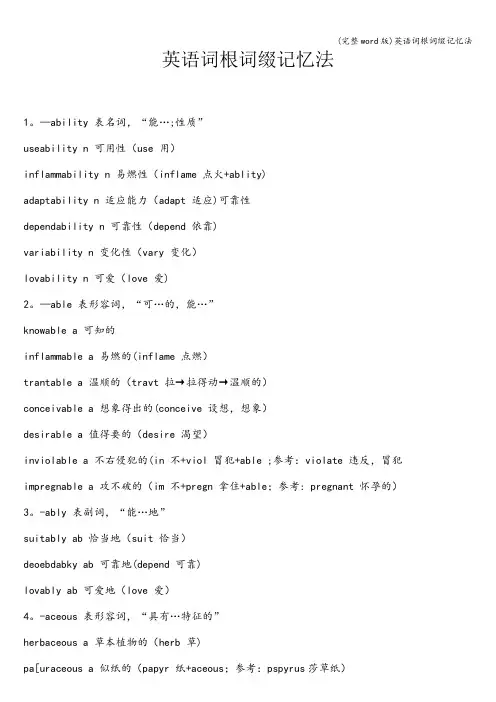
英语词根词缀记忆法1。
—ability 表名词,“能…;性质”useability n 可用性(use 用)inflammability n 易燃性(inflame 点火+ablity)adaptability n 适应能力(adapt 适应)可靠性dependability n 可靠性(depend 依靠)variability n 变化性(vary 变化)lovability n 可爱(love 爱)2。
—able 表形容词,“可…的,能…”knowable a 可知的inflammable a 易燃的(inflame 点燃)trantable a 温顺的(travt 拉→拉得动→温顺的)conceivable a 想象得出的(conceive 设想,想象)desirable a 值得要的(desire 渴望)inviolable a 不右侵犯的(in 不+viol 冒犯+able ;参考:violate 违反,冒犯impregnable a 攻不破的(im 不+pregn 拿住+able;参考: pregnant 怀孕的)3。
-ably 表副词,“能…地”suitably ab 恰当地(suit 恰当)deoebdabky ab 可靠地(depend 可靠)lovably ab 可爱地(love 爱)4。
-aceous 表形容词,“具有…特征的”herbaceous a 草本植物的(herb 草)pa[uraceous a 似纸的(papyr 纸+aceous;参考:pspyrus莎草纸)curvacious a 有曲线美的(curve 曲线)foliaceous a 叶状的(foli 叶+aceous;参考:foliage 树叶)5。
-acious 表形容词,“有特征的,多…的”rapacious a 掠夺成性的(rape 掠夺,强奸)sagacious a 睿智的(sage 智者)capacious a 宽敞的(cap 能→的+acious;参考:capble有能力的)fallacious a 错误的(fall 错;参考:fallacy 谬误)vivacious a 活泼的(viv 活;参考:revive 复活)audacious a 大胆的(aud 大胆+acious;名词:audacity大胆)veracious a 真实的(ver 真;参考:verify 证实)lopuacious a 啰唆的(loqu 讲话;参考:eloquent 雄辩)salacious a 好色的(sal 跳→见到女人就跳起来→好色)tenacious a 固执的(ten 拿住;参考:tenable 防守得住的)sequacious a 前后连贯的(sequ=secu 跟随;参考:persecute 迫害)voracious a 贪婪的(vor 吃;参考:omnivorous 无所不吃的)6。
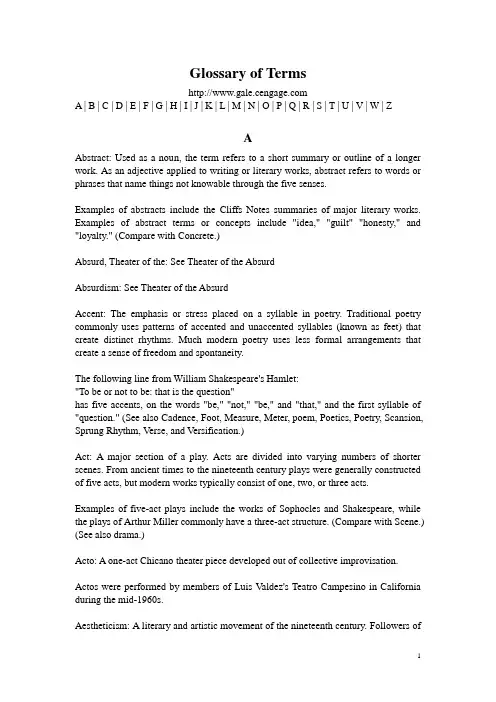
Glossary of TermsA |B |C |D |E |F |G |H |I |J |K |L |M |N |O |P |Q |R |S |T |U |V |W | ZAAbstract: Used as a noun, the term refers to a short summary or outline of a longer work. As an adjective applied to writing or literary works, abstract refers to words or phrases that name things not knowable through the five senses.Examples of abstracts include the Cliffs Notes summaries of major literary works. Examples of abstract terms or concepts include "idea," "guilt" "honesty," and "loyalty." (Compare with Concrete.)Absurd, Theater of the: See Theater of the AbsurdAbsurdism: See Theater of the AbsurdAccent: The emphasis or stress placed on a syllable in poetry. Traditional poetry commonly uses patterns of accented and unaccented syllables (known as feet) that create distinct rhythms. Much modern poetry uses less formal arrangements that create a sense of freedom and spontaneity.The following line from William Shakespeare's Hamlet:"To be or not to be: that is the question"has five accents, on the words "be," "not," "be," and "that," and the first syllable of "question." (See also Cadence, Foot, Measure, Meter, poem, Poetics, Poetry, Scansion, Sprung Rhythm, Verse, and Versification.)Act: A major section of a play. Acts are divided into varying numbers of shorter scenes. From ancient times to the nineteenth century plays were generally constructed of five acts, but modern works typically consist of one, two, or three acts.Examples of five-act plays include the works of Sophocles and Shakespeare, while the plays of Arthur Miller commonly have a three-act structure. (Compare with Scene.) (See also drama.)Acto: A one-act Chicano theater piece developed out of collective improvisation. Actos were performed by members of Luis Valdez's Teatro Campesino in California during the mid-1960s.Aestheticism: A literary and artistic movement of the nineteenth century. Followers ofthe movement believed that art should not be mixed with social, political, or moral teaching. The statement "art for art's sake" is a good summary of aestheticism. The movement had its roots in France, but it gained widespread importance in England in the last half of the nineteenth century, where it helped change the Victorian practice of including moral lessons in literature.Oscar Wilde is one of the best-known "aesthetes" of the late nineteenth century. (See also Decadents.)Affective Fallacy: (Also known as Sympathetic Fallacy.) An error in judging the merits or faults of a work of literature. The "error" results from stressing the importance of the work's effect upon the reader —that is, how it makes a reader "feel" emotionally, what it does as a literary work —instead of stressing its inner qualities as a created object, or what it "is."The affective fallacy is evident in Aristotle's precept from his Poeticsthat the purpose of tragedy is to evoke "fear and pity" in its spectators.Age of Johnson: (Also known as Age of Sensibility). The period in English literature between 1750 and 1798, named after the most prominent literary figure of the age, Samuel Johnson. Works written during this time are noted for their emphasis on "sensibility," or emotional quality. These works formed a transition between the rational works of the Age of Reason, or Neoclassical period, and the emphasis on individual feelings and responses of the Romantic period.Significant writers during the Age of Johnson included the novelists Ann Radcliffe and Henry Mackenzie, dramatists Richard Sheridan and Oliver Goldsmith, and poets William Collins and Thomas Gray. (Compare with Neoclassicismand romanticism.)Age of Reason: See NeoclassicismAge of Sensibility: See Age of JohnsonAgrarians: A group of Southern American writers of the 1930s and 1940s who fostered an economic and cultural program for the South based on agriculture, in opposition to the industrial society of the North. The term can refer to any group that promotes the value of farm life and agricultural society.Members of the original Agrarians included John Crowe Ransom, Allen Tate, and Robert Penn Warren.Alexandrine Meter: See MeterAllegory: A narrativetechnique in which characters representing things or abstractideas are used to convey a message or teach a lesson. Allegory is typically used to teach moral, ethical, or religious lessons but is sometimes used for satiric or political purposes.Examples of allegorical works include Edmund Spenser's The Faerie Queene and John Bunyan's The Pilgrim's Progress.(See also Exemplumand Fable.)Alliteration: A poetic device where the first consonant sounds or any vowel sounds in words or syllables are repeated.The following description of the Green Knight from the anonymous Sir Gawain and the Green Knight gives an example of alliteration:And in guise all of green, the gear and the man:A coat cut close, that clung to his sidesAn a mantle to match, made with a liningOf furs cut and fitted — the fabric was noble....(Compare with Assonanceand rhyme.) (See also poem, Poetics, Poetry, Verse, and Versification.)Allusion: A reference to a familiar literary or historical person or event, used to make an idea more easily understood.For example, describing someone as a "Romeo" makes an allusion to William Shakespeare's famous young lover in Romeo and Juliet.Amerind Literature: The writing and oral traditions of Native Americans. Native American literaturewas originally passed on by word of mouth, so it consisted largely of stories and events that were easily memorized. Amerind proseis often rhythmic like Poetry because it was recited to the beat of a ceremonial drum.Examples of Amerind literature include the autobiographical Black Elk Speaks, the works of N. Scott Momaday, James Welch, and Craig Lee Strete, and the poetry of Luci Tapahonso.Analogy: A comparison of two things made to explain something unfamiliar through its similarities to something familiar, or to prove one point based on the acceptedness of another. Similes and metaphors are types of analogies.Analogies often take the formof an extended simile, as in William Blake's aphorism: "As the caterpillar chooses the fairest leaves to lay her eggs on, so the priest lays his curse on the fairest joys." (Compare with Simileand Metaphor.)Anapest: See FootAngry Young Men: A group of British writers of the 1950s whose work expressed bitterness and disillusionment with society. Common to their work is an anti-hero who rebels against a corrupt social order and strives for personal integrity.The term has been used to describe Kingsley Amis, John Osborne, Colin Wilson, John Wain, and others.Antagonist: The major characterin a narrativeor dramawho works against the heroor protagonist.An example of an evil antagonist is Richard Lovelace in Samuel Richardson's Clarissa, while a virtuous antagonist is Macduff in William Shakespeare's Macbeth.(Compare with protagonist.) (See also anti-hero, conflict.)Anthropomorphism: The presentation of animals or objects in human shape or with human characteristics. The term is derived from the Greek word for "human form."The Fables of Aesop, the animated films of Walt Disney, and Richard Adams's Watership Downfeature anthropomorphic characters. (Compare with Personification.) Anti-hero: A central characterin a work of literature who lacks traditional heroic qualities such as courage, physical prowess, and fortitude. Anti-heros typically distrust conventional values and are unable to commit themselves to any ideals. They generally feel helpless in a world over which they have no control. Anti-heroes usually accept, and often celebrate, their positions as social outcasts.A well-known anti-hero is Yossarian in Joseph Heller's novel Catch-22.(Compare with Antagonist, Hero, and Protagonist.)Antimasque: See MasqueAnti-novel: A term coined by French critic Jean-Paul Sartre. It refers to any experimental work of fictionthat avoids the familiar conventions of the novel. The anti-novel usually fragments and distorts the experience of its characters, forcing the reader to construct the reality of the story from a disordered narrative.The best-known anti-novelist is Alain Robbe-Grillet, author of Le voyeur.Antithesis: The antithesis of something is its direct opposite. In literature, the use of antithesis as a figure of speech results in two statements that show a contrast through the balancing of two opposite ideas. Technically, it is the second portion of the statement that is defined as the "antithesis"; the first portion is the "thesis."An example of antithesis is found in the following portion of Abraham Lincoln's "Gettysburg Address"; notice the opposition between the verbs "remember" and "forget" and the phrases "what we say" and "what they did": "The world will little note nor long remember what we say here, but it can never forget what they did here."Apocrypha: Writings tentatively attributed to an author but not proven or universally accepted to be their works. The term was originally applied to certain books of the Bible that were not considered inspired and so were not included in the "sacred canon."Geoffrey Chaucer, William Shakespeare, Thomas Kyd, Thomas Middleton, and John Marston all have apocrypha. Apocryphal books of the Bible include the Old Testament's Book of Enoch and New Testament's Gospel of Thomas.Apollonian and Dionysian: The two impulses believed to guide authors of dramatic tragedy. The Apollonian impulse is named after Apollo, the Greek god of light and beauty and the symbol of intellectual order. The Dionysian impulse is named after Dionysus, the Greek god of wine and the symbol of the unrestrained forces of nature. The Apollonian impulse is to create a rational, harmonious world, while the Dionysian is to express the irrational forces of personality.Friedrich Nietzche uses these terms in The Birth of Tragedyto designate contrasting elements in Greek tragedy. (Compare with classicismand romanticism.) Apostrophe: A statement, question, or request addressed to an inanimate object or concept or to a nonexistent or absent person.Requests for inspiration from the musesin poetry are examples of apostrophe, as is Marc Antony's address to Caesar's corpse in William Shakespeare's Julius Caesar: "O, pardon me, thou bleeding piece of earth,That I am meek and gentle with these butchers!...Woe to the hand that shed this costly blood!..."(Compare with Monologueand Soliloquy.)Apprenticeship Novel: See BildungsromanArchetype: The word archetype is commonly used to describe an original pattern or model from which all other things of the same kind are made. This term was introduced to literary criticismfrom the psychology of Carl Jung. It expresses Jung's theory that behind every person's "unconscious," or repressed memories of the past, lies the "collective unconscious" of the human race: memories of the countless typical experiences of our ancestors. These memories are said to prompt illogical associations that trigger powerful emotions in the reader. Often, the emotional process is primitive,even primordial. Archetypes are the literary images that grow out of the "collective unconscious." They appear in literatureas incidents and plots that repeat basic patterns of life. They may also appear as stereotyped characters.Examples of literary archetypes include themes such as birth and death and characters such as the Earth Mother.Argument: The argument of a work is the author's subject matter or principal idea.Examples of defined "argument" portions of works include John Milton's Arguments to each of the books of Paradise Lost and the "Argument" to Robert Herrick's Hesperides.Aristotelian Criticism: Specifically, the method of evaluating and analyzing tragedy formulated by the Greek philosopher Aristotle in his Poetics.More generally, the term indicates any form of criticismthat follows Aristotle's views. Aristotelian criticism focuses on the form and logical structure of a work, apart from its historical or social context, in contrast to "Platonic Criticism," which stresses the usefulness of art. Adherents of New Criticism including John Crowe Ransom and Cleanth Brooks utilize and value the basic ideas of Aristotelian criticism for textual analysis. (Compare with Platonic Criticism.) (See also catharsis, New Criticism.)Art for Art's Sake: See Aestheticism.Aside: A comment made by a stage performer that is intended to be heard by the audiencebut supposedly not by other characters.Eugene O'Neill's Strange Interlude is an extended use of the aside in modern theater.Assonance: The repetition of similar vowel sounds in Poetry.The following lines from Gerald Manley Hopkins's "God's Grandeur" contain several patterns of assonance:The world is charged with the grandeur of God.It will flame out, like shining from shook foil;It gathers to a greatness, like the ooze of oilCrushed. Why do men then now not reck his rod?(Compare with Alliteration, Dissonance, and rhyme.)Audience: The people for whom a piece of literatureis written. Authors usually write with a certain audience in mind, for example, children, members of a religious or ethnic group, or colleagues in a professional field. The term "audience" also applies to the people who gather to see or hear any performance, including plays, Poetryreadings, speeches, and concerts.Jane Austen's parody of the gothic novel, Northanger Abbey, was originally intended for (and also pokes fun at) an audience of young and avid female gothic novel readers.Autobiography: A connected narrative in which an individual tells his or her life story.Examples include Benjamin Franklin's Autobiography and Henry Adams's The Education of Henry Adams.(Compare with Biography.) (See also Diaryand Memoirs.)Automatic Writing: Writing carried out without a preconceived plan in an effort to capture every random thought. Authors who engage in automatic writing typically do not revise their work, preferring instead to preserve the revealed truth and beauty of spontaneous expression.Automatic writing was employed by many of the Surrealist writers, notably the French poetRobert Desnos. (See also Surrealism.)Avant-garde: A French term meaning "vanguard." It is used in literary criticismto describe new writing that rejects traditional approaches to literaturein favor of innovations in style or content.Twentieth-century examples of the literary avant-gardeinclude the Black Mountain Schoolof poets, the Bloomsbury Group, and the Beat Movement.BBallad: A short poem that tells a simple story and has a repeated refrain. Ballads were originally intended to be sung. Early ballads, known as folk ballads, were passed down through generations, so their authors are often unknown. Later ballads composed by known authors are called literary ballads.An example of an anonymous folk ballad is "Edward," which dates from the Middle Ages. Samuel Taylor Coleridge's "The Rime of the Ancient Mariner" and John Keats's "La Belle Dame sans Merci" are examples of literary ballads. (Compare with Corrido and Oral Transmission.)Baroque: A term used in literary criticism to describe literature that is complex or ornate in style or diction. Baroque works typically express tension, anxiety, and violent emotion. The term "Baroque Age" designates a period in Western European literature beginning in the late sixteenth century and ending about one hundred years later. Works of this period often mirror the qualities of works more generally associated with the label "baroque" and sometimes feature elaborate conceits. Examples of Baroque works include John Lyly's Euphues: The Anatomy of Wit, Luisde Gongora's Soledads, and William Shakespeare's As You Like It.Baroque Age: See BaroqueBaroque Period: See BaroqueBeat Generation: See Beat MovementBeat Movement: A period featuring a group of American poets and novelists of the 1950s and 1960s — including Jack Kerouac, Allen Ginsberg, Gregory Corso, William S. Burroughs, and Lawrence Ferlinghetti —who rejected established social and literary values. Using such techniques as stream of consciousness writing and jazz-influenced free Verse and focusing on unusual or abnormal states of mind —generated by religious ecstasy or the use of drugs — the Beat writers aimed to create works that were unconventional in both form and subject matter.Kerouac's On the Roadis perhaps the best-known example of a Beat Generation novel, and Ginsberg's Howlis a famous collection of Beat Poetry.Beat Poets: See Beat MovementBeats, The: See Beat MovementBelles-lettres: A French term meaning "fine letters" or "beautiful writing." It is often used as a synonym for literature, typically referring to imaginative and artistic rather than scientific or expository writing. Current usage sometimes restricts the meaning to light or humorous writing and appreciative essays about literature.Lewis Carroll's Alice in Wonderland epitomizes the realm of belles-lettres.Bildungsroman: (Also known as Apprenticeship Novel, Coming of Age Novel, Erziehungsroman, or Kunstlerroman.) A German word meaning "novel of development." The bildungsromanis a study of the maturation of a youthful character, typically brought about through a series of social or sexual encounters that lead to self-awareness. Bildungsroman is used interchangeably with erziehungsroman,a novel of initiation and education. When a bildungsroman is concerned with the development of an artist (as in James Joyce's A Portrait of the Artist as a Young Man), it is often termed a kunstlerroman.Well-known bildungsromane include J. D. Salinger's The Catcher in the Rye, Robert Newton Peck's A Day No Pigs Would Die, and S. E. Hinton's The Outsiders. Biography: A connected narrative that tells a person's life story. Biographies typically aim to be objective and closely detailed. James Boswell's The Life of SamuelJohnson,LL.D is a famous example of the form. (Compare with Autobiography and Memoirs.Black Aesthetic Movement: (Also known as Black Arts Movement.) A period of artistic and literary development among African Americans in the 1960s and early 1970s. This was the first major African-American artistic movement since the Harlem Renaissance and was closely paralleled by the civil rights and black power movements. The black aesthetic writers attempted to produce works of art that would be meaningful to the black masses. Key figures in black aesthetics included one of its founders, poet and playwright Amiri Baraka, formerly known as LeRoi Jones; poet and essayist Haki R. Madhubuti, formerly Don L. Lee; poet and playwright Sonia Sanchez; and dramatist Ed Bullins.Works representative of the Black Aesthetic Movement include Amiri Baraka's play Dutchman, a 1964 Obie award-winner; Black Fire: An Anthology of Afro-American Writing,edited by Baraka and playwright Larry Neal and published in 1968; and Sonia Sanchez's poetry collection We a BaddDDD People, published in 1970.Black Arts Movement: See Black Aesthetic MovementBlack Comedy: See Black HumorBlack Humor: (Also known as Black Comedy.) Writing that places grotesque elements side by side with humorous ones in an attempt to shock the reader, forcing him or her to laugh at the horrifying reality of a disordered world.Joseph Heller's novel Catch-22 is considered a superb example of the use of black humor. Other well-known authors who use black humor include Kurt V onnegut, Edward Albee, Eugene Ionesco, and Harold Pinter.Black Mountain School: Black Mountain College and three of its instructors —Robert Creeley, Robert Duncan, and Charles Olson —were all influential in projective verse, so poets working in projective verse are now referred as members of the Black Mountain school.The Black Mountain Review published much of the work of Black Mountain school poets.Blank Verse: Loosely, any unrhymed poetry, but more generally, unrhymed iambic pentameter verse(composed of lines of five two-syllable feet with the first syllable accented, the second unaccented). Blank verse has been used by poets since the Renaissance for its flexibility and its graceful, dignified tone.John Milton's Paradise Lostis in blank verse, as are most of William Shakespeare's plays.(See also Accent, Foot, Measure, and Meter.)Bloomsbury Group: A group of English writers, artists, and intellectuals who heldinformal artistic and philosophical discussions in Bloomsbury, a district of London, from around 1907 to the early 1930s. The Bloomsbury Group held no uniform philosophical beliefs but did commonly express an aversion to moral prudery and a desire for greater social tolerance.At various times the circle included Virginia Woolf, E. M. Forster, Clive Bell, Lytton Strachey, and John Maynard Keynes.Bon Mot: A French term meaning "good word." A bon mot is a witty remark or clever observation.Charles Lamb and Oscar Wilde are celebrated for their witty bon mots. Two examples by Oscar Wilde stand out: (1) "All women become their mothers. That is their tragedy. No man does. That's his." (2) "A man cannot be too careful in the choice of his enemies."Breath Verse: See Projective VerseBurlesque: Any literary work that uses exaggeration to make its subject appear ridiculous, either by treating a trivial subject with profound seriousness or by treating a dignified subject frivolously. The word "burlesque" may also be used as an adjective, as in "burlesque show," to mean "striptease act."Examples of literary burlesque include the comedies of Aristophanes, Miguel de Cervantes's Don Quixote,, Samuel Butler's poem "Hudibras," and John Gay's play The Beggar's Opera.(Compare with Parody.)CCadence: The natural rhythm of language caused by the alternation of accented and unaccented syllables. Much modern Poetry—notably free Verse —deliberately manipulates cadence to create complex rhythmic effects.James Macpherson's "Ossian poems" are richly cadenced, as is the poetry of the Symbolists, Walt Whitman, and Amy Lowell. (Compare with Meter.)Caesura: A pause in a line of Poetry, usually occurring near the middle. It typically corresponds to a break in the natural rhythm or sense of the line but is sometimes shifted to create special meanings or rhythmic effects.The opening line of Edgar Allan Poe's "The Raven" contains a caesura following "dreary": "Once upon a midnight dreary, while I pondered weak and weary...." (Compare with Cadence.)Canzone: A short Italian or Provencal lyric poem, commonly about love and often set to music. The canzonehas no set form but typically contains five or six stanzas made up of seven to twenty lines of eleven syllables each. A shorter, five- to ten-line "envoy," or concluding stanza, completes the poem.Masters of the canzone form include Petrarch, Dante Alighieri, Torquato Tasso, andGuido Cavalcanti.Carpe Diem: A Latin term meaning "seize the day." This is a traditional theme of Poetry, especially lyrics. A carpe diem poem advises the reader or the person it addresses to live for today and enjoy the pleasures of the moment.Two celebrated carpe diem poems are Andrew Marvell's "To His Coy Mistress" and Robert Herrick's poem beginning "Gather ye rosebuds while ye may...."Catharsis: The release or purging of unwanted emotions — specifically fear and pity — brought about by exposure to art. The term was first used by the Greek philosopher Aristotle in his Poeticsto refer to the desired effect of tragedy on spectators.A famous example of catharsis is realized in Sophocles' Oedipus Rex,when Oedipus discovers that his wife, Jacosta, is his own mother and that the stranger he killed on the road was his own father. (See also Aristotelian Criticism.)Celtic Renaissance: (Also known as Celtic Twilight.) A period of Irish literary and cultural history at the end of the nineteenth century. Followers of the movement aimed to create a romantic vision of Celtic myth and legend. The most significant works of the Celtic Renaissance typically present a dreamy, unreal world, usually in reaction against the reality of contemporary problems.William Butler Yeats's The Wanderings of Oisinis among the most significant works of the Celtic Renaissance. (Compare with Irish Literary Renaissanceand romanticism.)Celtic Twilight: See Celtic RenaissanceCharacter: Broadly speaking, a person in a literary work. The actions of characters are what constitute the plot of a story, novel, or poem. There are numerous types of characters, ranging from simple, stereotypical figures to intricate, multifaceted ones. In the techniques of Anthropomorphismand personification, animals —and even places or things — can assume aspects of character. "Characterization" is the process by which an author creates vivid, believable characters in a work of art. This may be done in a variety of ways, including (1) direct description of the character by the narrator; (2) the direct presentation of the speech, thoughts, or actions of the character; and (3) the responses of other characters to the character. The term "character" also refers to a form originated by the ancient Greek writer Theophrastus that later became popular in the seventeenth and eighteenth centuries. It is a short essay or sketch of a person who prominently displays a specific attribute or quality, such as miserliness or ambition.Notable characters in literature include Oedipus Rex, Don Quixote de la Mancha, Macbeth, Candide, Hester Prynne, Ebenezer Scrooge, Huckleberry Finn, Jay Gatsby, Scarlett O'Hara, James Bond, and Kunta Kinte.Characterization: See CharacterChorus: In ancient Greek drama, a group of actors who commented on and interpreted the unfolding action on the stage. Initially the chorus was a major component of the presentation, but over time it became less significant, with its numbers reduced and its role eventually limited to commentary between Acts. By the sixteenth century the chorus — if employed at all — was typically a single person who provided a prologue and an epilogue and occasionally appeared between acts to introduce or underscore an important event.The chorus in William Shakespeare's Henry Vfunctions in this way. Modern dramas rarely feature a chorus, but T. S. Eliot's Murder in the Cathedral and Arthur Miller's A View from the Bridge are notable exceptions. The Stage Manager in Thornton Wilder's Our Town performs a role similar to that of the chorus.Chronicle: A record of events presented in chronological order. Although the scope and level of detail provided varies greatly among the chronicles surviving from ancient times, some, such as the Anglo-Saxon Chronicle,feature vivid descriptions and a lively recounting of events. During the Elizabethan Age, many dramas —appropriately called "chronicle plays" — were based on material from chronicles. Many of William Shakespeare's dramas of English history as well as Christopher Marlowe's Edward II are based in part on Raphael Holinshead's Chronicles of England, Scotland, and Ireland.Classical: In its strictest definition in literary criticism, classicism refers to works of ancient Greek or Roman literature. The term may also be used to describe a literary work of recognized importance (a "classic") from any time period or literature that exhibits the traits of classicism.Classical authors from ancient Greek and Roman times include Juvenal and Homer. Examples of later works and authors now described as classical include French literature of the seventeenth century, Western novels of the nineteenth century, and American fiction of the mid-nineteenth century such as that written by James Fenimore Cooper and Mark Twain.Classicism: A term used in literary criticism to describe critical doctrines that have their roots in ancient Greek and Roman literature, philosophy, and art. Works associated with classicism typically exhibit restraint on the part of the author, unity of design and purpose, clarity, simplicity, logical organization, and respect for tradition. Examples of literary classicism include Cicero's prose, the dramas of Pierre Corneille and Jean Racine, the Poetry of John Dryden and Alexander Pope, and the writings of J. W. von Goethe, G. E. Lessing, and T. S. Eliot.Climax: The turning point in a narrative, the moment when the conflict is at its most intense. Typically, the structure of stories, novels, and plays is one of rising action, in which tension builds to the climax, followed by falling action, in which tension lessens as the story moves to its conclusion.。
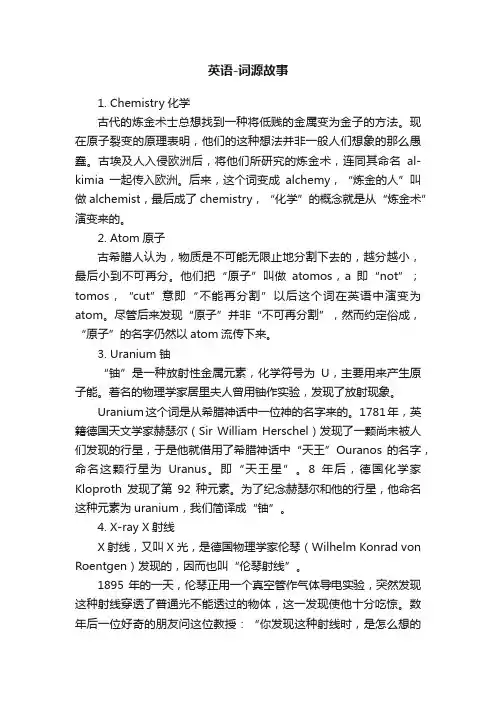
英语-词源故事1. Chemistry化学古代的炼金术士总想找到一种将低贱的金属变为金子的方法。
现在原子裂变的原理表明,他们的这种想法并非一般人们想象的那么愚蠢。
古埃及人入侵欧洲后,将他们所研究的炼金术,连同其命名al-kimia一起传入欧洲。
后来,这个词变成alchemy,“炼金的人”叫做alchemist,最后成了chemistry,“化学”的概念就是从“炼金术”演变来的。
2. Atom原子古希腊人认为,物质是不可能无限止地分割下去的,越分越小,最后小到不可再分。
他们把“原子”叫做atomos,a即“not”;tomos,“cut”意即“不能再分割”以后这个词在英语中演变为atom。
尽管后来发现“原子”并非“不可再分割”,然而约定俗成,“原子”的名字仍然以atom流传下来。
3. Uranium铀“铀”是一种放射性金属元素,化学符号为U,主要用来产生原子能。
着名的物理学家居里夫人曾用铀作实验,发现了放射现象。
Uranium这个词是从希腊神话中一位神的名字来的。
1781年,英籍德国天文学家赫瑟尔(Sir William Herschel)发现了一颗尚未被人们发现的行星,于是他就借用了希腊神话中“天王”Ouranos 的名字,命名这颗行星为Uranus。
即“天王星”。
8年后,德国化学家Kloproth发现了第92种元素。
为了纪念赫瑟尔和他的行星,他命名这种元素为uranium,我们简译成“铀”。
4. X-ray X射线X射线,又叫X光,是德国物理学家伦琴(Wilhelm Konrad von Roentgen)发现的,因而也叫“伦琴射线”。
1895年的一天,伦琴正用一个真空管作气体导电实验,突然发现这种射线穿透了普通光不能透过的物体,这一发现使他十分吃惊。
数年后一位好奇的朋友问这位教授:“你发现这种射线时,是怎么想的呢?”“我什么也没想”,他回答说,“我在做实验”。
这位物理学家命名字这种射线为X-strahlen,译成英文为X-ray,这里“X”的意思是说这种射线的性质尚未探明,还是一个未知数。
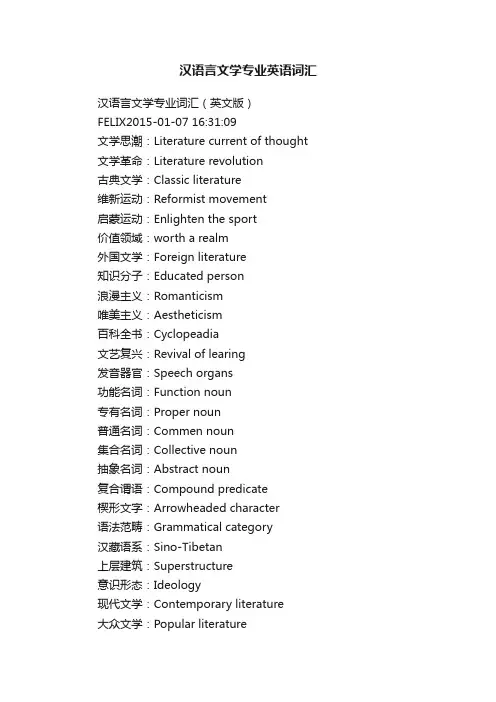
汉语言文学专业英语词汇汉语言文学专业词汇(英文版)FELIX2015-01-07 16:31:09文学思潮:Literature current of thought 文学革命:Literature revolution古典文学:Classic literature维新运动:Reformist movement启蒙运动:Enlighten the sport价值领域:worth a realm外国文学:Foreign literature知识分子:Educated person浪漫主义:Romanticism唯美主义:Aestheticism百科全书:Cyclopeadia文艺复兴:Revival of learing发音器官:Speech organs功能名词:Function noun专有名词:Proper noun普通名词:Commen noun集合名词:Collective noun抽象名词:Abstract noun复合谓语:Compound predicate楔形文字:Arrowheaded character语法范畴:Grammatical category汉藏语系:Sino-Tibetan上层建筑:Superstructure意识形态:Ideology现代文学:Contemporary literature大众文学:Popular literature报告文学:Reportage批判主义:Criticism伊索寓言:Aesop`s Fables希腊文化:Hellenism形而上学:Metaphysis孔子学说:Confucian喜怒哀乐:Pleasure Anger Sorrow Joy发源地:Source爱美剧:Amateur修辞学:Rhetoric语音学:Phonetic助动词:Auxiliary verb感叹词:Interjection连接词:Link word逻辑词:Logical word里程碑:Milestone拉丁语:Latin田园诗:Idyl无名氏:Annymous person真善美:Truth Goodness Beauty英语分类词汇:文学相关词汇classical literature 古典文学contemporary literature 现代文学popular literature 大众文学light literature 通俗文学folklore 民间文学saga (river) novel 长篇小说short novel, long short story 中篇小说short story 短篇小说love story 爱情小说deterctive story 侦破小说mystery story 怪诞小说whodunit 推理小说humorous story 幽默小说historical novel 历史小说essay 随笔book of travels 游记reportage 报告文学criticism 评论best seller 畅销书anthology 选集the complete works(of) 全集edition, printing 版masterpiece 杰作copyright 版权, 著作权deluxe binding 精装flat stitching 平装smyth sewed 线装humanities 人文学科writer 作家book 书volume 卷theatre 戏剧(美作:theater)drama 话剧comedy 喜剧tragedy 悲剧farce 滑稽剧play 剧本the three unities 三一律(一个情节,一个地点,一个时间) playwright 编剧act 幕scene 场plot 情节Appendix 1 A Glossary of Linguistic T ermsAabbreviation []n. 缩写.缩写词.略语ablative []n.夺格a.夺格的absolute []a.独立的.独立成分absolute clause 独立从句abstract nouns 抽象名词accent []n.口音.重音.(诗歌中词或音节的)重读accidence []n.1.词形变化.字形变化2. (学科的)初步.入门accommodation []n.调适.接纳accusative []a.直接宾格的n.直接宾格(受格)acoustic []a.听觉的.音响的.声学的(---feature/cue声学特征)acquisition []n.获得.习得acronym []n.首字母缩略字.缩略词active []n.主动语态actor []n.动作者.行动者(actor—action—goal)addition []n. 加.附加.添加address []n. 称呼(forms/terms of address 称呼语)addressee []n. 受话人,收信人,收件人addresser []n. 发话人,发言人,发信人.adjacency pair 相邻语对adjective []n.形容词a.形容词的adjunct []n.附加语.修饰语.修饰成分adnominal []a.(定语)修饰名词的.形容词的.形容名词的adverb []n. 副词;状语adverbial []a. 副词的,作副词用的adversative []a.反意的.相反的n.反义字(转折语) affirmative []n.肯定词.肯定语affix []n1.附加物.添加物2.字缀.词缀(affix hopping 词缀跳跃) affixation[]n. 附加.附加法.词缀附加法affricate []n.塞擦音agent (agentive) 施事agreement []n. (人称.性别.数.格的)一致airstream []n.气流alliteration []n.头韵(法)allomorph []n.同质异形体.词.语素变体allophone []n.同位音.音位变体allophonic variation 音位变体alveolar []n. 齿龈音,齿槽音.alveolar ridge 齿龈ambiguity []n.含混,歧义ambiguous歧义的anacoluthon []n.改变说法.错格.句法结构前后不一anadiplosis []n.反复法.顶真analogical []a.类似的.类推的analogical creation 类推造字anapaest []n.抑抑扬格.弱弱强格.短短长格anaphora []n. 复指.首语(句)重复法annotation []n. 注解.注释antecedent []n. (关系代词的)先行词antithesis []n. 1. 对立面;对立2. (修辞学)对语,对偶,对句antonomasia []n. 代称,称呼替换antonym []n. 反义词,反义现象aphorism []n.格言.警句.箴言aposiopesis []n.话语中断,说话中断法apostrophe []n. 1.呼语2.撇号3.省略符号4.所有格符号appellative []a.1.名称的2.通称的n.通称名词.普通名词apposition []n. 1.同位语2.并置appropriateness []n. 得体.适合.适当.相称arbitrariness []n. 任意性archaism []n.古体,拟古,古语argot []n.行语,暗语,黑话article []n.冠词articulation []n. (清楚的)发音.发出的(辅)音.发音动作articulator []n. 1.发音清楚的人或物2.发音器官articulatory []a.发音清晰的.与发音有关的aside 旁白,私语,离题话aspect []n. (动词的) 体. 时态. 时间aspirated []a.伴有h音的.送气音的.吐气.送气assimilation []n.同化aureate []a.绚丽的(-- diction,绚丽辞令–style绚丽体)assonance []n. 1. 谐音2. (诗的)准押韵.半谐音attributive []a. 1.归属的.属性的2.定语的n.定语auxiliary []a. 辅助的.附属的.从属的n.助词auxiliary verb 助动词Bback-formation 逆构词法base form 基础形式base component 基础部分basic form 基本形式behaver 行为者behavioural process 行为过程behaviourism 行为主义bilabial []a.双唇音的n. 双唇音bilabial nasal 双唇鼻音bilateral []a.双边的.双边音bilateral opposition 双边对立bilingualism [] n.双语现象binary []a. 二元的.由二部分构成的(-- feature 二分特征) binomial []a. 二项式的n.二项式blade []n.舌叶.舌面前部blank verse 无韵诗bleaching []n.词义淡化blending []n.混合.混成法.裁切block language 块语、标题式语言(有限语境中使用缩略结构如No smoking) borrow(ing) 借用.借词bound clause粘附句bound morpheme 粘着语素bounding theory 界限理论bracketing 括号法broad transcription 宽式音标broadening 词义扩大Ccalque []n.语义转借.译借vt.转借(语义).仿造语cardinal[]n基数词cardinal vowel 基本元音category []n范畴(categorical component 范畴成分)causative []a.使役的n.使役动词cavity []n.腔clause 小句.从句click 吸气音.咂音clipping []n.缩略closure []n.关闭.闭塞cluster []辅音丛coarticulation 协同发音coda []n.节尾.韵尾code 语码.信码cognate []n.同源词.同根词.同系语言cognitive psycholinguistics 认知心理语言学cognitive psychology 认知心理学cognitive system 认知系统coherence 连贯.相关.关联cohension 衔接collapse [] 叠合collective []n.集合名词colligation []n. 概括.搭连collocation []n.组合.搭配command []命令(句)commissive 承诺语common普通的.共同的(--- core 共核)(--- noun 普通名词)comparative [] a比较的.比较级的competence []n.语言能力complement(ation) 补语complementary互补.相反component 组成部分,成分componential 组成部分的composition 组构compound(ing) 复合;复合词(句)conative []a. 意动的concord []n. 协调.一致(关系)conditional []n.条件句.条件语congruence []n.重合conjugate []vt.列举(动词)的词形变化conjunct []a. 连接副词conjunction []n.连词.连接词connotation []n.含蓄.言外之意【逻】内涵consonant[]n.辅音.辅音字母a.辅音的constative []a. 陈述的.表述的constituent []n.成分.结构成分construction (construct) 构建content (ive) 内容.实义(词)contrast(ive) 对立.对比convention(al) 常规;规约conversation 会话conversationalconversion 类转.变换coordinate /coordination/coordiative 并列copula []n.系词copulative []a.连系的.作系词的n.系词co-referential(ity) 同指coronal []n.舌冠(音).舌尖音corpus []n. 1.文集.全2..躯体(尤指尸体) 3.语料语料库.素材corpora[] (corpus的复数)correlative []a.相关的n.关联词count [] 可数的,countable/uncontable 可/不可数名词couplet []n. 对句.双韵covert []隐性的Ddactyl []n. (英诗的)扬抑抑格.长短短格dative []a.与格的n.与格.与格语dative movement 与格移动declarative []a. 1. 宣言的.布告的.申报的.陈述的2.陈述的decode []vt. 译解(密码)deductive []a. 推论的.演绎的defeasibility 消除可行性definite []a.1. 明确的.确切的2. 一定的.肯定的3. 限定的deictic []a. 直证的.直指的(deixis)denotation []n. 1. 意义.本义2. 表示3. 名称.符号dental []a. 齿音的n.齿音dentalization 齿音化derivation []n.诱导.来历.起源调查.语言derivational []a.诱导的. 衍生的;引出的determiner []n.限定词deviant []a. 越轨的n.不正常者.变异物.变体deviation 偏离;变异devoice []vt.使(有声之音)变为无声之音devoicing 清音化diachronic []a.历时的diachronic linguistics 历时语言学diacritic []a.有区别的.能区分的.辨别的n.区别发音符号dialect []n. 方言.土话dialectology 方言学diphthong []n.双元音.复合元音direct object 直接宾语direct speech直接言语discourse []n.语段.语篇;话语discrete []a. 1. 分离的.不连接的2.抽象的disjunction []n. 分离.分裂displacement []n.移位.置换.取代dissimilation []n. 1. 异化2.异化作用3.异化distinguish []vt.区别.识别把...区别分类distinguisher 辩义成分domain []n. 领域.范围dorsal []a.背部的.背侧的舌背音.舌中音dorsum []n.背.背状部分.舌面(舌尖以后之部分)dual []n. 1. 双数2. 双数词dualistic []a. 二元的.二元论的duality 二重性Eejective []a. 喷出的.外射的n.外爆音ellipsis []n.省略.省略部分elliptic(al) []a. 1. 椭圆的2.省略的encode []vt. 1. 把...译成电码(或密码)endocentric []a.向心的.内向的epenthesis []n.增音.插入字母epithet []n. 1. 表示特征的修饰词2. (描述性的)称号equipollent[]a.相等的n. 相等物equivalence 相等equivoque []n. 双关语.模棱两可的词句.语义双关euphemism []n.. 婉转说法.委婉(词)语euphony []n. 声音的和谐.谐音.悦耳语音exocentric []a. 外心的。
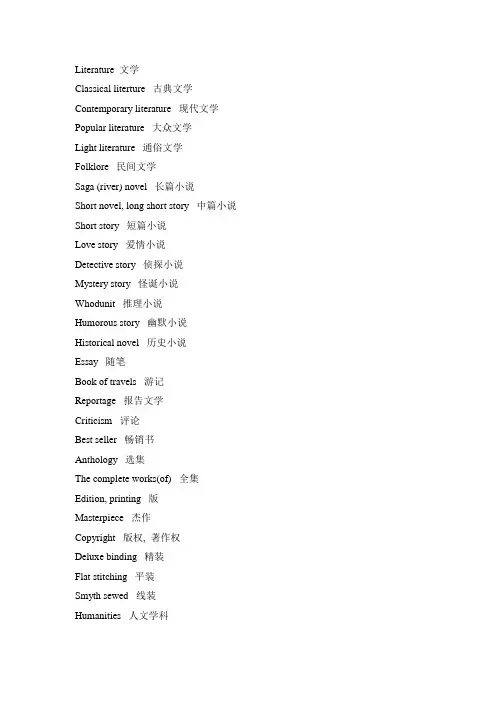
Literature 文学Classical literture 古典文学Contemporary literature 现代文学Popular literature 大众文学Light literature 通俗文学Folklore 民间文学Saga (river) novel 长篇小说Short novel, long short story 中篇小说Short story 短篇小说Love story 爱情小说Detective story 侦探小说Mystery story 怪诞小说Whodunit 推理小说Humorous story 幽默小说Historical novel 历史小说Essay 随笔Book of travels 游记Reportage 报告文学Criticism 评论Best seller 畅销书Anthology 选集The complete works(of) 全集Edition, printing 版Masterpiece 杰作Copyright 版权, 著作权Deluxe binding 精装Flat stitching 平装Smyth sewed 线装Humanities 人文学科Writer 作家Book 书V olume 卷Theatre 戏剧(美作theater)Drama 话剧Comedy 喜剧Tragedy 悲剧Farce 滑稽剧Play 剧本The three unities 三一律(一个情节,一个地点,一个时间) Playwright 编剧Act 幕Scene 场Plot 情节Intrigue 错综复杂的剧情Story 故事Episode 逸事Ending, denouement 结局Poetry 诗歌Poet 诗人Poem 诗Epic poetry 史诗Epopee 叙事诗Ode 颂歌Sonnet 十四行诗Verse, stanza (诗)节Line (诗)行Rhyme 韵脚,押韵Metrics 韵律学,格律学Prose 散文Novel 小说Biography 自传Allegory 寓言Science fiction 科幻,科学幻想小说Satire 讽刺诗Essay 杂文Composition 学术著作Rhetoric 修辞学Oratory 讲演术Declamation 朗诵技巧Improvisation 即席讲演Criticism 批判主义Critic 批评家Wit 才智,创作才能Eloquence 文才Lyricism 抒情性。
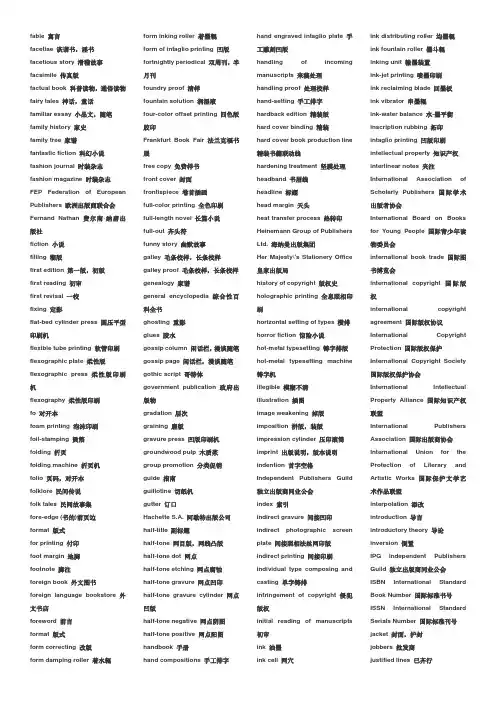
fable 寓言facetiae 诙谐书,淫书facetious story 滑稽故事facsimile 传真版factual book 科普读物,通俗读物fairy tales 神话,童话familiar essay 小品文,随笔family history 家史family tree 家谱fantastic fiction 科幻小说fashion j ournal 时装杂志fashion magazine 时装杂志FEP Federation of European Publishers 欧洲出版商联合会Fernand Nathan 费尔南·纳唐出版社fiction 小说filling 糊版first edition 第一版,初版first reading 初审first revisal 一校fixing 定影flat-bed cylinder press 圆压平型印刷机flexible tube printing 软管印刷flexographic plate 柔性版flexographic press 柔性版印刷机flexography 柔性版印刷fo 对开本foam printing 泡沫印刷foil-stamping 烫箔folding 折页folding machine 折页机folio 页码,对开本folklore 民间传说folk tales 民间故事集fore-edge (书的)前页边format 版式for printing 付印foot margin 地脚footnote 脚注foreign book 外文图书foreign language bookstore 外文书店forew ord 前言format 版式form correcting 改版form damping roller 着水辊form inking roller 着墨辊form of intaglio printing 凹版fortnightly periodical 双周刊,半月刊foundry proof 清样fountain solution 润湿液four-color offset printing 四色版胶印Frankfurt Book Fair 法兰克福书展free copy 免费样书front cover 封面frontispiece 卷首插画full-color printing 全色印刷full-length novel 长篇小说full-out 齐头符funny story 幽默故事galley 毛条校样,长条校样galley proof 毛条校样,长条校样genealogy 家谱general encyclopedia 综合性百科全书ghosting 重影glues 胶水gossip column 闲话栏,漫谈随笔gossip page 闲话栏,漫谈随笔gothic script 哥特体government publication 政府出版物gradation 层次graining 磨版grav ure press 凹版印刷机groundw ood pulp 木质浆group promotion 分类促销guide 指南guillotine 切纸机gutter 订口Hachette S.A. 阿歇特出版公司half-title 副标题half-tone 网目版,网线凸版half-tone dot 网点half-tone etching 网点腐蚀half-tone grav ure 网点凹印half-tone grav ure cylinder 网点凹版half-tone negativ e 网点阴图half-tone positiv e 网点阳图handbook 手册hand compositions 手工排字hand engraved int aglio plate 手工雕刻凹版handling of incomingmanuscripts 来稿处理handling proof 处理校样hand-setting 手工排字hardback edition 精装版hard cover binding 精装hard cover book production line精装书籍联动线hardening treatment 坚膜处理headband 书眉线headline 标题head margin 天头heat transfer process 热转印Heinemann Group of PublishersLtd. 海纳曼出版集团Her Majesty\'s St ationery Office皇家出版局history of copyright 版权史holographic printing 全息照相印刷horizontal setting of types 横排horror fiction 惊险小说hot-metal typesetting 铸字排版hot-metal typesetting machine铸字机illegible 模糊不清illustration 插图image weakening 掉版imposition 拼版,装版impression cylinder 压印滚筒imprint 出版说明,版本说明indention 首字空格Independent Publishers Guild独立出版商同业公会index 索引indirect grav ure 间接凹印indirect photographic screenplate 间接照相法丝网印版indirect printing 间接印刷indiv idual type composing andcasting 单字铸排infringement of copyright 侵犯版权initial reading of manuscript s初审ink 油墨ink cell 网穴ink distributing roller 均墨辊ink fountain roller 墨斗辊inking unit 输墨装置ink-jet printing 喷墨印刷ink reclaiming blade 回墨板ink v ibrator 串墨辊ink-water balance 水-墨平衡inscription rubbing 拓印intaglio printing 凹版印刷intellectual property 知识产权interlinear notes 夹注International A ssociation ofScholarly Publishers 国际学术出版者协会International Board on Booksfor Young People 国际青少年读物委员会international book trade 国际图书博览会international copyright 国际版权international copyrightagreement 国际版权协议International CopyrightProtection 国际版权保护International Copyright Society国际版权保护协会International IntellectualProperty Alliance 国际知识产权联盟International PublishersAssociation 国际出版商协会International Union for theProtection of Literary andArtistic Works 国际保护文学艺术作品联盟interpolation 添改introduction 导言introductory theory 导论inv ersion 倒置IPG Independent PublishersGuild 独立出版商同业公会ISBN International St andardBook Number 国际标准书号ISSN International St andardSerials Number 国际标准刊号jacket 封面,护封j obbers 批发商j ustified lines 已齐行kind of type 字体Kluwer Academic Publishers Group 克吕韦尔学术出版集团LA The Library Association 英国图书馆协会lacquered film engraving stencil 刻漆膜丝网印版lacquered screen plate 涂漆丝网印版laminating 复膜large print 大字版本laser engraved grav ure 激光雕刻凹版laser printer 激光打印机laser printing 激光印刷law of publication 出版法leaf 书的一页(包括正反面)lead-in 加铅条legal deposit 法定送样本legend 传奇legends under illustrations 图注letterpress machine 凸版印刷机letterpress make-ready 凸印上版letterpress printing 凸版印刷letterset 间接凸印lexicographical book 辞书Librairie Ernest Flammarion 欧内斯特·弗拉马里翁出版社Librairie Larousse 拉鲁斯出版社library edition 图书馆版Library of Congress 美国国会图书馆licensing 许可,许可证light literature 闲书light reading 闲书limitation of copyright 版权限止limited edition 特定版,限印本line 行line composing and casting 整行铸排line copy 线条原稿line et ching 线条腐蚀line space 行空Linotype 莱诺(整行)铸排机liquid crystal printing 液晶印刷list 目录literary agent 文稿代理人literary remains 遗著literary scenario 电影文学剧本literary scouts 寻稿人literary sketch 文学小品literature 文学lithographic 平版印刷lithographic plate 平版local chronicles 地方志local gazetteer 地方志local history 地方志local literature 乡土文学London International Book Fair伦敦国际书展long-term development 长期规划loose-leaf 活页loose-leaf binding 活页装lov e story 恋爱小说lower 改低lyric poetry 抒情诗machine readable code 机器阅读码,条形码machinery for post pressfinishing 印后加工机械macropedia 大百科全书magenta 品红色magnetic ink printing 磁性印刷maiden w ork 处女作mail-order 邮购mail-order for books 图书邮购maj or development proj ects 重大选题make-up 拼版manual phototypesetting 手动照相排版manuscript 原稿manuscript report 稿件审查报告,初审报告map paper 地图纸margin 页边空白,版口market 市场marketing 销售部marketing cost s 销售成本mask 蒙片masking 蒙版mass market paperback 大众市场纸皮书Masson 马松出版公司matrix grid 字模版memoirs 回忆录memorial v olume 纪念册merchandising 销售规划meshcount 丝网目数metal decorating 铁皮印刷micro books 缩微图书microcomputerphototypesetting terminal 微机排版终端microcopy 缩微本micro-dictionary 小型词典microfiche 缩微平片micro glossary 缩微平片micropedia 小百科全书micro-reproduction 缩微制品minstrelsy 歌谣集minute 备忘录miscellanea 杂记,杂集,杂录miscellany 杂记,杂集,杂录mobile booksellers 流动书贩moire 龟纹monochrome 单色印刷monograph 专题论文monographic series 专集Monotype 莫诺(单字)铸排机move to left 左移move to right 右移multi-color printing 多色印刷multilingual dictionary 多语种辞典multi-metal plate 多层金属版multi-v olume series 大型丛书must book 必读书mystery 神秘小说,侦探小说mythology 神话national bibliography 全国总书目national catalogue of new books全国新书目national copyright law s 国家版权法net sales income 净销售收入new edition 修订版,新版new paragraph 另起一行new sletter 书讯new spaper printing 报纸印刷new spaper printing press 报刊印刷机new sprint 新闻纸,白报纸new sprint in reel 新闻纸New Year card 贺年卡nip 压印线nonfiction books 非小说图书non-impact printing 无压印刷nonprofit publishing 非盈利出版notch binding 凹口装订note 注解notes 随笔,题记not-for-profit publishing 非盈利出版novel 小说novelette 中篇小说number of pages 页数NYP Not Yet Published 未出版obj ect original 实物原稿oct 八开本octav o 八开本octodecimo 十八开本offprint 选印本,抽印本offset 胶印offset lithography 胶印offset printing 胶印,平版印刷offset printing press 胶印机offset process 胶印法offset fee 复制费one side coated 单光纸only extent copy 孤本OP Out Of Print 绝版opacity 不透明度option on future books 书稿优先选择权order processing 订单处理original 原稿original book 原版original edition 原版ow ner of copyright 版权所有人,著作权人out 漏排outline 概要,纲要out of print edition 脱销版,绝版out of register 套印不准outside readers 外审。
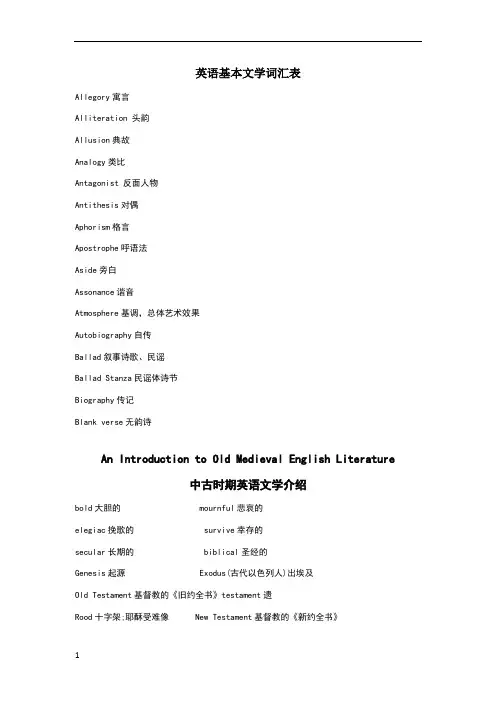
英语基本文学词汇表Allegory寓言Alliteration 头韵Allusion典故Analogy类比Antagonist 反面人物Antithesis对偶Aphorism格言Apostrophe呼语法Aside旁白Assonance谐音Atmosphere基调,总体艺术效果Autobiography自传Ballad叙事诗歌、民谣Ballad Stanza民谣体诗节Biography传记Blank verse无韵诗An Introduction to Old Medieval English Literature中古时期英语文学介绍bold大胆的 mournful悲哀的elegiac挽歌的 survive幸存的secular长期的 biblical圣经的Genesis起源 Exodus(古代以色列人)出埃及Old Testament基督教的《旧约全书》testament遗Rood十字架;耶酥受难像 New Testament基督教的《新约全书》portray描绘 warrior战士,武士stride跨过 In addition to除…之外epic史诗 doctrine说教evoke唤起,引起 harshness严肃circumstance环境,境况 lot命运harsh荒芜的 sorrowful悲伤的fatalistic宿命论的 courageous有勇气的determined有决心的 typical典型的setting bards吟游诗人 minstrel吟游诗人(或歌手)script原本,手迹 funeral葬礼impend即将发生;进行威 exploit开拓Scandinavia斯堪的那维亚(半岛)(瑞典、挪威、丹麦、冰岛的泛称revengeful报复的,深藏仇恨的 sequence次序glorious光荣的 Thematically从主题上说primitive远古的;原始的 wage发动Hostile force敌对邪恶势力 mighty强大的,有力的mingling混合 mingle embody具体表达ruddy红的 Rome-backed barren单调的,不孕的flourish繁荣 utter发表;反射style, tone, genre风格、语气、流派presentation表达 accurate精确的originality创新 absent缺少salvation拯救narrative verse叙述诗 prose散文Romance骑士(传奇)文学 characteristic典型的motif主题;动机;主旨 quest寻求encounter遭遇 beloved所爱的人accomplish完成;实现 infidelity失真maiden少女;处女liberal自由主义的;不拘泥的 improbable不可能的supernatural不可思仪的事,超自然的 mysteries神秘的事物fantasies幻想 plot情节;结构Characterization人物创造;描述 standardize使标准化wicked邪恶的 episodic插话式的straightforward坦率地;简单的,直接的 aristocratic贵族化的chivalric有骑士风度的a gallery of一系列(gallery,走廊)masterpiece名著,杰作 aristocracy贵族,贵族政府be conscious of知道 ideals理想;观念的;唯心论的practical matter实际事物 detached分离art巧妙 peculiarly特有的asceticism禁欲主义 quick wit 敏捷,聪明的才智expose揭露 satirize讽刺abuse陋习;滥用;虐待;辱骂 essentially本质humanism人文主义 anticipated预示的observant 奉行者,遵守法律或规章、习俗的人ever-present经常存在的 clash冲突temperament气质;性情 comic喜剧的;滑稽的ironic讽刺的 obtainable可得到的distinctions区别;特性 bourgeoisie资产阶级depict描写 asserting声称;断言artistic艺术的 alliterative verse头韵的octosyllabic八音节的诗句 couplet对句(双行诗)rhymed couplet iambic抑扬格诗 pentameter五步格诗heroic couplet英雄体双行诗 ease 安逸prosody诗体论;作诗法;韵律学 virtually事实上strife斗争,冲突 sect宗派,教派,流派opposing adj.相反的,对立的 India印度Roman Catholicism天主教 Anglican Church英国国教Dissenter非国教派的人 divergence分歧West Indies西印度群岛 adequate adj.足够的standardized标准的,定型的 privileged adj.有特权的plundered n.抢劫,战利品 self-restraint自制self-reliance自我实现 furtherance n.促进philosophical adj.哲学的 celebrate v.赞美rationality n.唯理性 Yardstick n.准绳Measurement n. 度量 superstition迷信injustice不公平 oppression 压力yield place to让步,屈服 dualistic二元的mass聚集 democratic adj.民主的didactic adj.说教的 moralize v.说教revival复苏 proportion比例unity统一 grace优雅,优美delight使喜悦 correct告诫primarily根本上,首先 urbane adj.文雅的witty adj.诙谐的 genre n.流派prose n.散文 direct adj.直接的smooth adj.流畅的 flexible adj.灵活的lyrical adj.抒情的 epical adj.叙事的satiric adj.讽刺的 Observed v.说,评述Heroic Couplets英雄体双行诗Represent v.扮演,表现 sentimentalists n.感伤主义in due time及时的 wholesome adj.健康的clarity n.清楚,透明 conciseness n.简明Permanent heritage永久遗产 school n.学派epigram n.讽刺短诗 arnestness adj.热心的。
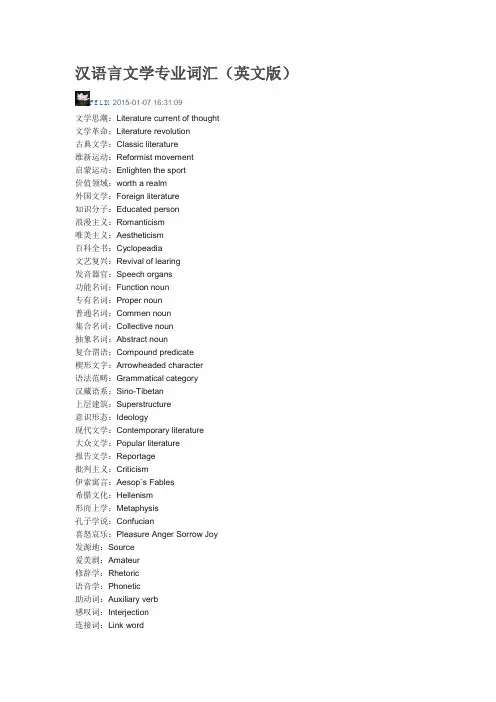
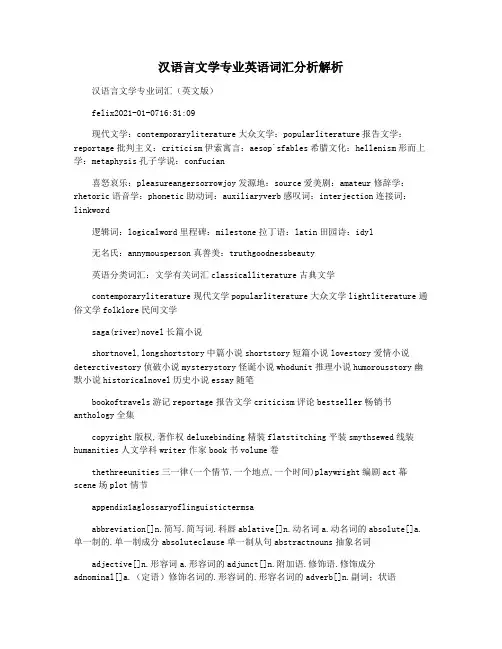
汉语言文学专业英语词汇分析解析汉语言文学专业词汇(英文版)felix2021-01-0716:31:09现代文学:contemporaryliterature大众文学:popularliterature报告文学:reportage批判主义:criticism伊索寓言:aesop`sfables希腊文化:hellenism形而上学:metaphysis孔子学说:confucian喜怒哀乐:pleasureangersorrowjoy发源地:source爱美剧:amateur修辞学:rhetoric语音学:phonetic助动词:auxiliaryverb感叹词:interjection连接词:linkword逻辑词:logicalword里程碑:milestone拉丁语:latin田园诗:idyl无名氏:annymousperson真善美:truthgoodnessbeauty英语分类词汇:文学有关词汇classicalliterature古典文学contemporaryliterature现代文学popularliterature大众文学lightliterature通俗文学folklore民间文学saga(river)novel长篇小说shortnovel,longshortstory中篇小说shortstory短篇小说lovestory爱情小说deterctivestory侦破小说mysterystory怪诞小说whodunit推理小说humorousstory幽默小说historicalnovel历史小说essay随笔bookoftravels游记reportage报告文学criticism评论bestseller畅销书anthology全集copyright版权,著作权deluxebinding精装flatstitching平装smythsewed线装humanities人文学科writer作家book书volume卷thethreeunities三一律(一个情节,一个地点,一个时间)playwright编剧act幕scene场plot情节appendix1aglossaryoflinguistictermsaabbreviation[]n.简写.简写词.科唇ablative[]n.动名词a.动名词的absolute[]a.单一制的.单一制成分absoluteclause单一制从句abstractnouns抽象名词adjective[]n.形容词a.形容词的adjunct[]n.附加语.修饰语.修饰成分adnominal[]a.(定语)修饰名词的.形容词的.形容名词的adverb[]n.副词;状语adverbial[]a.副词的,作副词用的adversative[]a.反意的.相反的n.反义字(转折语)affirmative[]n.肯定词.肯定语affix[]n1.附加物.添加物2.字缀.词缀(affixhopping词缀跳跃)affixation[]n.附加.附加法.词缀附加法affricate[]n.塞擦音agent(agentive)施事agreement[]n.(人称.性别.数.格的)一致airstream[]n.气流alliteration[]n.头韵(法)allomorph[]n.同质异形体.词.语素变体allophone[]n.同位音.音位变体allophonicvariation音位变体alveolar[]n.齿龈音,齿槽音.alveolarridge齿龈ambiguity[ambiguous歧义的anacoluthon[]n.含混,歧义]n.发生改变观点.错格.句法结构前后不一anadiplosis[]n.反复法.顶真analogical[]a.类似的.类推的analogicalcreation类推造字anapaest[]n.抑抑扬格.弱弱强格.短短长格anaphora[]n.复指.首语(句)重复法annotation[]n.注释.注解antecedent[]n.(关系代词的)先行词antithesis[]n.1.对立面;矛盾2.(修辞学)对语,对偶,对句antonomasia[]n.代称,称谓替代antonym[]n.反义词,反义现象aphorism[]n.格言.警句.箴言aposiopesis[]n.话语中断,骂人中断法apostrophe[]n.1.呼语2.竖钩号3.省略符号4.所有格符号appellative[]a.1.名称的2.俗称的n.俗称名词.普通名词apposition[]n.1.同位语2.棘劫appropriateness[]n.庄重.适宜.适度.为重arbitrariness[]n.任意性archaism[]n.古体,拟古,古语argot[]n.行语,暗语,黑话article[]n.冠词articulation[]n.(确切的)发音.收到的(辅)音.发音动作articulator[]n.1.发音确切的人或物2.发音器官articulatory[]a.发音准确的.与发音有关的aside片头,私语,离题话aspect[]n.(动词的)体.时态.时间aspirated[]a.伴有h音的.送气音的.吐气.送气assimilation[]n.同化aureate[]a.绚丽的(--diction,绚丽辞令cstyle绚丽体)assonance[]n.1.谐音2.(诗的)准押韵.半谐音attributive[]a.1.归属的.属性的2.定语的n.定语auxiliary[]a.辅助的.附属的.从属的n.助词auxiliaryverb助动词bback-formation逆构词法baseform基础形式behaviouralprocess行为过程behaviourism行为主义bilabial[]a.双唇音的n.双唇音bilabialnasal双唇鼻音bilateral[]a.双边的.双边音bilateralopposition双边对立。
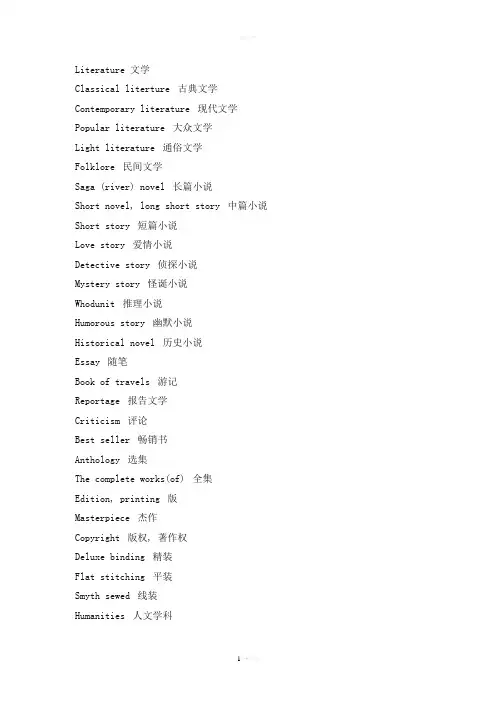
Literature 文学Classical literture 古典文学Contemporary literature 现代文学Popular literature 大众文学Light literature 通俗文学Folklore 民间文学Saga (river) novel 长篇小说Short novel, long short story 中篇小说Short story 短篇小说Love story 爱情小说Detective story 侦探小说Mystery story 怪诞小说Whodunit 推理小说Humorous story 幽默小说Historical novel 历史小说Essay 随笔Book of travels 游记Reportage 报告文学Criticism 评论Best seller 畅销书Anthology 选集The complete works(of) 全集Edition, printing 版Masterpiece 杰作Copyright 版权, 著作权Deluxe binding 精装Flat stitching 平装Smyth sewed 线装Humanities 人文学科Writer 作家Book 书Volume 卷Theatre 戏剧 (美作theater)Drama 话剧Comedy 喜剧Tragedy 悲剧Farce 滑稽剧Play 剧本The three unities 三一律(一个情节,一个地点,一个时间) Playwright 编剧Act 幕Scene 场Plot 情节Intrigue 错综复杂的剧情Story 故事Episode 逸事Ending, denouement 结局Poetry 诗歌Poet 诗人Poem 诗Epic poetry 史诗Epopee 叙事诗Ode 颂歌Sonnet 十四行诗Verse, stanza (诗)节Line (诗)行Rhyme 韵脚,押韵Metrics 韵律学,格律学Prose 散文Novel 小说Biography 自传Allegory 寓言Science fiction 科幻,科学幻想小说Satire 讽刺诗Essay 杂文Composition 学术著作Rhetoric 修辞学Oratory 讲演术Declamation 朗诵技巧Improvisation 即席讲演Criticism 批判主义Critic 批评家Wit 才智,创作才能Eloquence 文才Lyricism 抒情性欢迎您的下载,资料仅供参考!致力为企业和个人提供合同协议,策划案计划书,学习资料等等打造全网一站式需求。
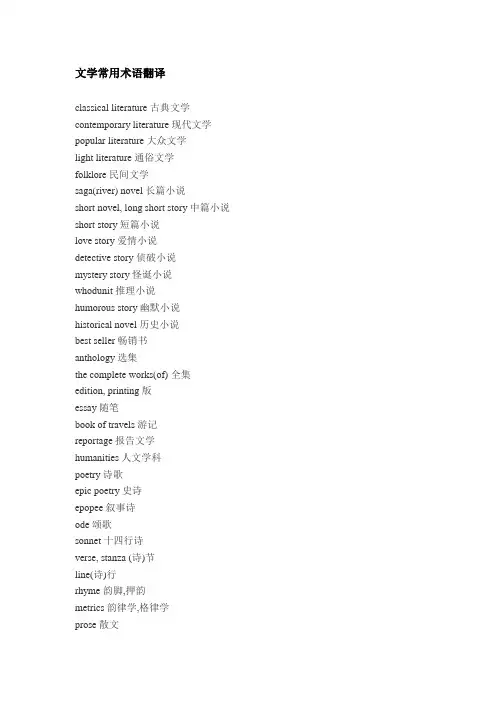
Aa/an (det)able (adj)be able toabout (adv & prep)? What about a cold drink?? I have about £3. (adv)? a book about animals (prep) above (adv & prep)accident (n)across (prep)? The bank’s across the road. ? He walked across the bridge.act (n & v) n.v.activity (n)actor (n)actually (adv)ad (n) ? an ad on TVadd (v)address (n)adult (adj & n)advanced (adj)adventure (n) advertisement (n)advice (n)aeroplane (n)afraid (adj)after (adv & prep)afternoon (n)afterwards (adv)again (adv)against (prep)? We watched England play against Franceage (n)? I don’t know his age.aged (adj) ago (adv)agree (v)? Yes, I agree with you.? Don’t you agree, Sam?air (n)? to travel by airairport (n)alarm clock (n)album (n)all (adv, det & pron)all right/alright (adj, adv &exclam)almost (adv)alone (adj & adv)along (prep)already (adv)also (adv)always (adv)a.m. (adv) (ante meridiem的缩写)amazing (adj)ambulance (n)among (prep)and (conj)angry (adj)animal (n)another (det & pron)answer (n & v)any (det & pron)anybody (pron)anymore (adv)anyone (pron)anything (pron)anyway (adv)anywhere (adv)apartment (n)apartment building (n)apple (n)appointment (n)? an appointment with thedoctorarea (n)arm (n)armchair (n)around (adv & prep)? to travel around (adv)? to sit around the table(prep)arrive (v)art (n)article (n)? an article about skiingartist (n)as (conj & prep) conj.? as good as? as soon as possible? the same asask (v)assistant (n)as well (adv)as well (as) (prep)at (prep)at / @ (prep)? My email address isat all? It doesn’t matter at all.attractive (adj)aunt (n)autumn (n)available (adj)away (adv)? He’s gone away.? It’s two miles away.awful (adj)Bbaby (n)back (n, adv & adj)backpack (n)bad (adj)badly (adv)badminton (n)bag (n)bake (v)ball (n)balloon (n)banana (n)band (n)bandage (n)bank (n)? I changed my money in the bank.barbecue (n)baseball (n)basketball (n)bat (n)bath (n)bathing suit (n)bathroom (n)bathtub (n)battery (n)be (av & v)beach (n)bean (n)bear (n)beard (n)beautiful(adj)because (conj)become (v)bed (n)bedroom (n)bee (n)beef (n)before (adv, conj & prep) begin (v)beginner (n)beginning (n)behind (adv & prep)believe (v)belong (v)below (adv & prep) belt (n)beside (prep)best (adj & adv)better (adj & adv)between (prep)bicycle (n)big (adj)bike (n)bill (n)? Can I have my bill, please?biology (n)bird (n)birth (n)birthday (n)biscuit (n) (Br Eng) (Am Eng:cookie)bit (n)? Just a small bit of cake,please.black (adj & n)blackboard (n)blanket (n)block (n)? Shall we walk round theblock?blond(e) (adj)blood (n)blouse (n)blue (adj & n)board (n)? The teacher’s writing on the(black/white)board.board game (n)boat (n)body (n)boil (v)boiled (adj)book (n & v)bookcase (n)bookshelf (n)bookshop (n) (Br Eng) (AmEng: bookstore)bookstore (n) (Am Eng) (BrEng: bookshop)boot (n)? a pair of boots? football bootsbored (adj)boring (adj)born (v) (bear的过去分词)(adj)? I was born in Manchester.borrow (v)? She borrowed a book fromthe library.boss (n)both (pron & det)bother (v)bottle (n)bottom (n)? at the bottom of the stairsbowl (n)box (n)boy (n)boyfriend (n)brake (n & v)brain (n)brave (adj)bread (n)break (n & v)? a break for lunch (n)? Someone’s broken thewindow.(v)breakfast (n)bridge (n)bright (adj)brilliant (adj)? I thought the film wasbrilliant!bring (v)broken (adj)brother (n)brown (adj & n)brush (n & v)build (v)building (n)burger (n)burn (v)? He has burnt his hand. bus (n)business (n) businessman (n) businesswoman (n)bus stationbus stopbusy (adj)but (conj)butter (n)buy (v)by (prep)bye (exclam)Ccabinet (n)cafe/café (n)cafeteria (n)cake (n)calendar (n)call (n & v)? I’ll call (phone) again la ter this afternoon.?He’s called John.? I’m waiting for a call from Anna.camel (n)camera (n)camp (v)camping (n)campsite (n)cap (n)capital (n) can (n, mv & aux)canal (n)candy (n)cannot (mv)car (n)card (n)? birthday card? credit cardcareer (n)careful (adj)? Be careful!carefully (adv)car park (n) (Br Eng) (Am Eng:parking lot)carpet (n)carrot (n)carry (v)cartoon (n)case (n)cash (n & v)? I’d like to cash this cheque.cassette (n)cassette playercassette recordercastle (n)cat (n)catch (v)cathedral (n)CD (n)CD player (n) CDceiling (n)cell phone (n)cent (n)centre/center (n)centimetre/centimeter (cm)(n)century (n)cereal (n)certain (adj)? I’m certain (+ that clause)certainly (not) (adv)chain (n)chair (n)change (v & n)channel (n)chat (n)chatroom (n)cheap (adj)check (v)Cheers (v)cheese (n)chef (n)chemist (n) (Br Eng) (Am Eng:drugstore)chemistry (n)cheque(n)chess (n)chicken (n)child (n)chilli (n)chips (n pl )? egg and chipschocolate (n)choose (v)church (n)cinema (n)circle (n)circus (n)city (n)class (n)? a language class? a first-class ticketclassmate (n)classroom (n)clean (adj & v)cleaner (n)clear (adj)? It’s not clear to me.clearly (adv)clever (adj)click (n & v)? click here to go to our websiteclimb (v)climbing (n)clock (n)close (adj & v) adj. close to (prep phr)closed (adj)clothes (n pl)cloud (n)cloudy (adj)clown (n)club (n)? to join a clubcoach (n) ? a coach trip? a tennis coachcoat (n)coffee (n)cola (n)cold (adj & n)colleague (n)collect (v)college (n)colour (n & v)comb (n)come (v)comfortable (adj)comic (n)company (n)? What’s the name of your company?competition (n)complete (v)computer (n)concert (n) congratulations! (exclam) contact (n & v) conversation (n)cook (n & v)cooker (n) cookie (n) (Am Eng) (Br Eng:biscuit)cooking (n)cool (adj & exclam) adj.? That’s a cool bike! (adj)copy (v)corner (n)? the corner of the streetcorrect (adj)cost (n & v)costume (n)? I forgot my swimmingcostume.could (mv)country (n)countryside (n)course (n)? a university course? a main course? of course (not)cousin (n)cover (v)cow (n)crazy (adj)cream (n)credit cardcricket (n)cross (n & v)? Don’t cross the road here!crossing (n)? Use the crossing to crossthe street.crossroads (n)crowd (n)crowded (adj)cry (v)? The baby’s crying.cup (n)cupboard (n)curry (n)curtain (n)customer (n)cut (v)cycle (v)cycling (n)Ddad (n)daily (adj & adv)dance (n & v)dancer (n)dancing (n)danger (n)dangerous (adj)dark (adj)date (n)? What’s the date today?daughter (n)day (n)dead (adj)dear (adj)? Dear Anne,decide (v)deep (adj)degree (n)? The temperature’s 30degrees today.delay (n & v)? There will be a delay of twohours. (n)? The flight is delayed. (v)dentist (n)department (n)department store (n)describe (v)desert (n)desk (n)dessert (n)detail (n)diary (n)dictionary (n)die (v)difference (n)different (adj)difficult (adj)digital (adj)digital camera (n)dining room (n)dinner (n)dinosaur (n)diploma (n)dirty (adj)disco (n)discount (n)discuss (v)dish (n)? Chicken and chips is my favorite dish.do (av & v)doctor (n)document (n)dog (n)doll (n)dollar (n)dolphin (n)door (n)dot (n)? dot comdouble (adj)? a double roomdown (adv & prep) download (n & v)? I downloaded the songs from the internet (v). downstairs (adv)Dr / doctor (n)draw (v)drawer (n)drawing (n)dream (n & v)dress (n & v)dressed (adj) drink (n & v)drive (v)driver (n)driving licencedrugstore (n) (Am Eng) (BrEng: chemist)drum (n)dry (adj & v)duck (n)during (prep)DVD (n)DVD playerEeach (det & pron)ear (n)early (adj & adv)earn (v)earring (n)easily (adv)east (n, adj & adv)easy (adj)eat (v)egg (n)electric (adj)electricity (n)elephant (n)elevator (n) (Am Eng) (Br Eng:lift)else (adv)? Anything else?email (n & v)empty (adj & v)end (v & n)engine (n)engineer (n)enjoy (v)enough (adv, det & pron)enter (v)? Are you going to enter theposter competition?? Please enter through theside door.entrance (n)envelope (n)eraser (n) (Am Eng) (Br Eng:rubber)especially (adv)Euro (n)even (adv)evening (n)ever (adv)every (det)everybody (pron)everyone (pron)everything (pron)everywhere (adv)exactly (adv)examination/exam (n)example (n)? Look at the example first.? for exampleexcellent (adj)except (conj & prep)excited (adj)exciting (adj)excuse (v)? Excuse me!exercise (n & v)exhibition (n)? art exhibitionexit (n)expensive (adj)explain (v)explore (v)explorer (n)? This book’s about famousexplorers.extra (adj)eye (n)Fface (n)fact (n)factory (n)fail (v)fair (adj)? She has fair hairfall (n & v)? in the fall (n) (Am Eng) (Br Eng: autumn)? he fell and hurt his leg (v) family (n)famous (adj)fan (n) ;(fans)fantastic (adj)far (adv)? How far is the next garage? farm (n)farmer (n)fashion (n)fast (adj & adv)fast food (n)fat (adj)father (n)favourite (adj)feel (v)? to feel wellfestival (n)few (det & adj)field (n)file (n)fill (v)fill in (phr v)? to fill in a formfilm (n)final (adj)finally (adv)find (v)find out (phr v)fine (adj)? That’s fine! ? I’m fine, thank you.? The weather is fine.finger (n)finish (v)fire (n)first (det, adv & adj)? First… then… (adv)? John came first. (adv)? first prize (adj)first name (n)fish (n & v)fishing (n)fit (adj)flat (n)flight (n)floor (n)? The bedrooms are on thefirst floor.? Don’t le ave your clothes onthe floor.flower (n)fly (n & v)fog (n)foggy (adj)follow (v)food (n)foot (n) ;(feet)? my right footfootball (n)footballer (n)for (prep)foreign (adj)forest (n)forget (v)fork (n)? knife and forkform (n)? Fill in this form.free (adj)French fries (n) (Am Eng) (BrEng: chips)fresh (adj)? fresh fruitfridge (n)fried (adj)friend (n)friendly (adj)from (prep)front (n)? in the front of the train? Stand in front of me.fruit (n)fry (v)full (of) (adj)fun (adj & n)funny (adj)furniture (n)further (adj)future (n)Ggame (n)garage (n)garden (n)garlic (n)gas (n) (Am Eng) (Br Eng:petrol)? a gas cookergas station (n) (Am Eng) (BrEng: petrol station)gate (n)geography (n)get (v)get fit (v)get off (phr v)? to get off the busget on (phr v)? to get on the busget up (phr v)? to get up in the morninggift (n)girl (n)girlfriend (n)give (v)glad (adj)glass (n)glasses (n pl)glove (n)go (v)goal (n)gold (n & adj);golden (adj) ;珍贵的;金制的golf (n)good (adj)good afternoon (exclam) goodbye (exclam)good evening (exclam) good-looking (adj)good morning (exclam) good night (exclam)go out (phr v)? Are you going out this evening?grade (n)gram(me) (n)grandchild (n)grand(d)ad (n) granddaughter (n) grandfather (n)grandma (n)grandmothergrandpa (n)grandparent (n)grandson (n)granny (n)grape (n)grass (n)great (adj)green (adj) grey (adj & n) (Br Eng) (AmEng: gray)grill (v)grilled (adj)grocery store (n) (Am Eng)group (n)grow (v)grow up (phr v)guess (v)guest (n)guest-house (n)guide (n)guidebook (n)guitar (n)guy (n)? He’s a really nice guy.gym (n)Hhair (n)hairdresser (n)hairdryer (n)half (det, n & pron)half-price (adj)hall (n)hand (n)handbag (n)happen (v)happy (adj)hard (adj & adv)? hard wood (adj)? the homework was hard(adj)? to work hard (adv)hat (n)hate (v)have (av & v)have got to (mv)have to (mv)he (pron)head (n)? My head hurts.headache (n)headteacher (n)health (n)healthy (adj)hear (v)heart (n)heating (n)? Can you turn the heatingon?heavy (adj)? a heavy blanket? How heavy is it?helicopter (n)Hello (exclaim)help (v)her (det & pron)here (adv)hers (pron)herself (pron)? by herselfhey (exclam)hi (exclam)high (adj)hill (n)him (pron)himself (pron)? by himselfhip hop (n)his (det & pron)history (n)hit (v)hobby (n)hockey (n)hold (v)holiday (n)home (n & adv)homework (n)honey (n)hope (v)horrible (adj)horse (n)hospital (n)hot (adj)hotel (n)hour (n)house (n) housewife (n)how (adv) however (adv) hungry (adj)hurry (v)hurt (v)husband (n)II (pron)ice (n)ice creamice skating (n)ID (n)ID card (n)idea (n) identification (n)if (conj)ill (adj) immediately (adv) important (adj) improve (v)in (adv & prep) include (v) including (prep) indoor (adj) indoors (adv) information (n)in front of (prep phr) insect (n)inside (adv & prep) instead (adv) instead of instructions (n pl) instrument (n)insurance (n)? car insuranceinterested (adj)interesting (adj)international (adj)internet (n)into (prep)invitation (n)invite (v)island (n)it (pron)IT (n) (informationtechnology)its (pron)itself (pron)Jjacket (n)jam (n)? fruit jamjazz (n)jeans (n)jewellery (n) (Br Eng) (AmEng: jewelry)job (n)join (v)journalist (n)journey (n)juice (n)jump (v)jumper (n)just (adv)? I’ve just seen Tom.? Just a moment.Kkeep (v)? May I keep this?? Keep right!key (n)keyboard (n)? I play the keyboard in aband.? The keyboard for mycomputer is broken.kick (n & v)kilogramme (kg) (n) (Br Eng)(Am Eng: kilogram)kilometre (km) (n) (Br Eng)(Am Eng: kilometer)kind (adj & n)? That’s very kind of you.? What kind of book do youwant?king (n)kiss (n & v)kit (n)kitchen (n)kite (n)knife (n)know (v)Llake (n)lamp (n)language (n)laptop (computer) (n)large (adj)last (adj & adv)late (adj & adv)? The train is going to be late.later (adv)? I’ll see you later.latest (adj)laugh (v)lazy (adj)learn (v)least (adv)? at leastleather (n & adj)leave (v)? The train leaves at 10o’clock.? I left my bag in the cinema. ? There isn’t any milk left. left (n, adj & adv)? Go to the left. (n)? left hand (adj)? Turn left. (adv)left-hand (adj)leg (n)lemon (n)lemonade (n)lend (v)less (det, adj & adv)lesson (n)let (v)letter (n)level (n)? language levellibrary (n)licence (n)? driving licencelie (v)lie down (phr v)life (n)lift (v&n)? Take the lift to the third floor.light (n & adj)like (v, prep & adv)? What’s the weather like? (adv)? It’s like an orange but bigger. (prep)? I’d like a drink. (v)line (n)? draw a line? the next linelion (n)list (n) listen (v)litre (n) (Br Eng) (Am Eng:liter)little (adj & det)live (v)living roomlong (adj)look (v)? You look happy.? Don’t look now!look after (phr v)look at (phr v)look for (phr v)look out (phr v)? Look out –it’s going to fall!lorry (n)lose (v)? We lost the game.? I’ve lost my passport.lost (adj)lot (det)lots / a lot (n)? a lot of homework.loud (adj)love (n & v)lovely (adj)low (adj)luck (n)lucky (adj)luggage (n)lunch (n)lunchtime (n)Mmachine (n)mad (adj)magazine (n)mail (n)main(adj)main course (n)make (v)make-up (n)man (n)manager (n)mango (n)many (det & pron)map (n)mark (n)market (n)married (adj)match (n)? football matchmaths/mathematics (n) (BrEng) (Am Eng: math)matter (n & v) n.? It doesn’t matter. (v)? What’s the matter? (n)may (mv)maybe (adv)me (pron)meal (n)mean (v)meat (n)mechanic (n)medicine (n)meet (v)meeting (n)melon (n)member (n)? a member of a clubmemory (n)menu (n)message (n)metre (n) (Br Eng) (Am Eng:meter)midday (n)middle (n)? in the middlemidnight (n)might (mv)mile (n)milk (n)million (n)mind (v)? Do you mind if I close the window?? I don’t mind if…? Never mind.? Mind your head!mine (pron)mineral waterminus (prep)minute (n)mirror (n)Miss (n)miss (v)missing (adj)mistake (n)mix (v)mobile (phone) (adj)model (n)modern (adj)moment (n)? Just a momentmoney (n)monkey (n)month (n)monthly (adj & adv)moon (n)more (adj, adv, det & pron) morning (n)most (adj, adv, det & pron) mother (n)motorbike (n)motorway (n)mountain (n)mouse (n)mouth (n)move (v)movie (n) (Am Eng) (Br Eng: film) movie theater (n) (Am Eng)(Br Eng: cinema)movie star (n) (Am Eng) (BrEng: film star)MP3 player (n) MP3Mr (n) (Mister的缩写)Mrs (n)Ms (n)much (adj, adv, det & pron)mug (n)mum (n)museum (n)mushroom (n)music (n)musical (adj)musician (n)must (mv)my (pron)myself (pron)? by myselfNname (n)national (adj)nationality (n)nature (n)near (adv & prep)nearly (adv)neck (n)necklace (n)need (v)neighbour (n)net (n)? I found a great website onthe net.never (adv)new (adj)news (n)newsagent (n)newspaper (n)next (adj & adv) 下next to (prep)nice (adj)night (n)no (adv, det & pron)nobody (pron)noise (n)noisy (adj)noon (n)no one (pron)none (pron)normal (adj)north (n, adj & adv)nose (n)not (adv)note (n & v)notebook (n)nothing (pron)notice (n)now (adv)nowhere (adv)number (n)nurse (n)Ooccupation (n)occupation diseaseo'clock (adv) …(等于of theclock)of (prep) …of course (adv)of course not (adv)off (adv)offer (n & v)office (n)often (adv)oh (exclam)oil (n)? car oil? cooking oilOK/O.K./okay (exclaim)old (adj)omelette (n)on (prep & adv)once (adv)? only onceone (pron, det & num)onion (n)online (adj & adv)only (adv & adj)? I only wanted to help.? the only oneopen (adj & v)opera (n)? Peking Operaopposite (prep)or (conj)orange (adj & n)order (n)other (det & pron)our (pron)ours (pron)ourselves (pron)out (adv)outdoor (adj)outdoors (adv)out of (prep)outside (prep & adv)over (prep & adv)? over 60 people (prep)? to travel all over the world (adv)own (adj)? They cook their own meals. Ppack (v)? pack a suitcasepage (n)pain (n) 苦paint (v & n)painter (n)painting (n) pale (adj)pair (n)? a pair of shoespaper (n & adj)? white paperpardon (v & n)? Pardon?parent (n)park (n & v)parking lot (n) (Am Eng) (BrEng: car park)part (n)? the best part of the daypartner (n)party (n)pass (v)? You pass the station on theleft.? to pass a driving testpassenger (n)passport (n)past (prep)pasta (n)path (n)pay (v)pay for (phr v)PC (personal computer) (n)个pear (n)pen (n)pence (n pl)pencil (n)pencil case (n)penfriend (n)penny (n)people (n)pepper (n)per (prep)perfect (adj)perfume (n)perhaps (adv)person (n)pet (n)petrol (n)petrol station (n)pharmacy (n)phone (v & n)photo(graph) (n)photographer (n)photography (n)physics (n)piano (n)pick up (phr v)picnic (n)picture (n)piece (n)? a piece of cakepillow (n)pilot (n)pink (adj)pity (n)? What a pity!pizza (n)place (n)plan (n & v)plane (n)? The plane was late.plant (n)plastic (n & adj)plate (n)platform (n)? Your train leaves fromPlatform 8.play (v & n)? to play football (v)? to play the guitar (v)? a play at the theatre (n)player (n)playground (n)pleasant (adj)please (v & exclam)? I’m very pleased for you. (v) ? Please be quiet!pleased (adj)plus (prep)p.m.pocket (n)point (v)police (n)police car (n)police officer (n)police stationpolite (adj)pool (n)? swimming poolpoor (adj)pop (n)? pop musicpopular (adj)possible (adj)possibly (adv)post (v & n)? to post a letter? What’s in the post today? postcard (n)post office (n)poster (n)potato (n)pound (£) (n)practice (n) (Br Eng) (Am Eng: practise)? football practicepractise (v)? You must practise if you want to play well.prefer (v)prepare (v)present (n)? a birthday presentpretty (adj) price (n)print (v)printer (n)prize (n)probably (adv)problem (n)program (n)? a computer programprogramme (n)? a TV programmeproject (n)? a school projectpull (v)pupil (n)purple (adj)purse (n)push (v)put (v)put on (phr v)puzzle (n)Qquarter (n)? a quarter of an hourqueen (n)question (n)quick (adj)quickly (adv)quiet (adj)quite (adv)? Are you quite sure?? quite oldquiz (n)Rrabbit (n)race (n & v)? a running race? She raced her brother tothe bus stop.racket (n)? Can I borrow your tennisracket?radio (n)railway (n)rain (n & v)raincoat (n)rap (n)rather (adv)? rather oldread (v)reading (n)ready (adj)? When will it be ready?real (adj)really (adv)reason (n)receipt (n)receive (v)receptionist (n)record (v)red (adj)refrigerator (n)remember (v)rent (v)repair (v)repeat (v)rest (n & v)? to have a rest? ‘Try to rest’, the doctor said.restaurant (n)return (n & v)? my return from holiday (n)? He returned home late. (v)? She returned her librarybooks. (v)rice (n)rich (adj)ride (v)right (n, adj & adv) n.? He swam to the right. (n)? your right hand (adj)? That’s the right answer. (adj)? Turn right here. (adv) right hand (adj)ring (n)river (n)road (n)roast (v & adj)rock (n)? rock concertroof (n)room (n)? a double roomround (adj)roundabout (n)rubber (n)rugby (n)ruin(s) (n)? Let’s visit the castle ruins today.ruler (n)run (v)runner (n)running (n)Ssad (adj)safe (adj)sail (v)sailing (n)salad (n)sale (n)? for salesalt (n)same (adj & pron)? at the same time (adj)? Your watch is the same as mine. (pron)sandwich (n)sauce (n) sausage (n)save (v)? to save money? to save timesay (v)scarf (n)? red scarfschool (n)schoolchild (n)science (n)scissors (n pl)scooter (n)screen (n)sea (n)seat (n)second (adj, det & n)secretary (n)see (v)sell (v)send (v)sentence (n)serve (v)set (n)several (det & pron)shall (mv)shame (n)? What a shame!shampoo (v & n)share (v)she (pron)sheep (n)sheet (n)? a bed sheetshelf (n)ship (n)shirt (n)shoe (n)shop (n & v)shop assistant (n)shopping (n)short (adj)? a short timeshorts (n pl)should (mv)shout (v)show (v & n)? Show me your photos.? a film showshower (n)shut (v)sick (adj)side (n)? this side of the roomsightseeing (n)sign (n)silver (n & adj)simple (adj)since (prep)sincerely (adv)? Yours sincerelysing (v)singer (n)singing (n)single (adj)sink (n)sister (n) 妹sit (v)sit down (phr v)site (n) 地点;sitting room (n)size (n)skate (v)skateboard (n)skateboarding (n)skating (n)ski (v)skiing (n)skirt (n)sky (n)sleep (v)slice (n)slim (adj)slow (adj)slowly (adv)small (adj)smoke (v)smoking (n)snack (n)snow (n & v)snowboard (n) snowboarding (n)so (conj & adv)? So, I think it’s right. (conj) ? He ate too much, so he felt ill. (conj)? He wanted to go but he didn’t say so. (adv)soap (n)soccer (n)sock (n)sofa (n)soft (adj)software (n)some (det & pron) somebody (pron)someone (pron)something (pron) sometimes (adv) somewhere (adv)son (n)song (n)soon (adv)sorry (adj)? I’m sorry I’m late.? Sorry, I don’t understand that.sort (n)sound (v)? That sounds nice.soup (n) south (n, adj & adv)space (n)spare (adj)speak (v)speaker (n)special (adj)spell (v) (spelt,spelt)spelling (n)spend (v) (spent,spent)spoon (n)sport (n)sports centre (n)spring (n)? I hate winter but I lovespring.square (n & adj)Set squarestadium (n)staff (n)stage (n)stairs (n pl)stamp (n)? Put a stamp on theenvelope.stand (v)? She was standing at thebus stop.star (n & v)start (v)station (n)stay (v)steak (n)steal (v)? Someone’s stolen my bag!still (adv)stomach (n)stomach ache (n)stop (n & v)store (n)storm (n)story (n)straight (adj & adv)? a straight line (adj)? Go straight on. (adv)strange (adj)? That’s a strange story!street (n)strong (adj)student (n)studies (n pl)study (v)subject (n)? What’s your favouritesubject at school?? the subject of a talksuch (det)suddenly(adv)sugar (n)suit (n)? He was wearing a grey suit.suitcase (n)summer (n)sun (n)sunglasses (n pl)sunny (adj)supermarket (n)supper (n)suppose (v)? I suppose so.? I suppose you’re right.sure (adj)? I’m (not) sure.surf (v)surfboard (n)surfing (n)surname (n)surprise (n)surprised (adj)sweater (n)sweet (n & adj)。
Literature 文学Classical literture 古典文学Contemporary literature 现代文学Popular literature 大众文学Light literature 通俗文学Folklore 民间文学Saga (river) novel 长篇小说Short novel, long short story 中篇小说Short story 短篇小说Love story 爱情小说Detective story 侦探小说H Mystery story 怪诞小说Whodunit 推理小说Humorous story 幽默小说Historical novel 历史小说Essay 随笔Book of travels 游记Reportage 报告文学Criticism 评论Best seller 畅销书Anthology 选集The complete works(of) 全集Edition, printing 版Masterpiece 杰作Copyright 版权, 著作权Deluxe binding 精装Flat stitching 平装Smyth sewed 线装Humanities 人文学科Writer 作家Book 书Volume 卷Theatre 戏剧(美作theater)Drama 话剧Comedy 喜剧Tragedy 悲剧Farce 滑稽剧Play 剧本The three unities 三一律(一个情节,一个地点,一个时间) Playwright 编剧Act 幕Scene 场Plot 情节Intrigue 错综复杂的剧情Story 故事Episode 逸事Ending, denouement 结局Poetry 诗歌Poet 诗人Poem 诗Epic poetry 史诗Epopee 叙事诗Ode 颂歌Sonnet 十四行诗Verse, stanza (诗)节Line (诗)行Rhyme 韵脚,押韵Metrics 韵律学,格律学Prose 散文Novel 小说Biography 自传Allegory 寓言Science fiction 科幻,科学幻想小说Satire 讽刺诗Essay 杂文Composition 学术著作Rhetoric 修辞学Oratory 讲演术Declamation 朗诵技巧Improvisation 即席讲演Criticism 批判主义Critic 批评家Wit 才智,创作才能Eloquence 文才Lyricism 抒情性。
❖American Transcendentalism A literary and philosophical movement, associated with Ralph Waldo Emerson and Margaret Fuller, asserting the existence of an ideal spiritual reality that transcends the empirical and scientific and is knowable through intuition. 超验主义:一种文学和哲学运动,与拉尔夫·沃尔多·爱默生和玛格丽特·富勒有关,宣称存在一种理想的精神实体,超越于经验和科学之处,通过直觉得以把握❖English Romanticism was an artistic, literary and intellectual movement that originated in the second half of the 18th century in Europe.❖ode in ancient literature, is an elaborate lyrical poem composed for a chorus to chant and to dance to; in modern use, it is a rhymed lyric expressing noble feelings, often addressed to a person or celebrating an event.❖conceit 奇喻A Valediction: Forbidding Mourning 。
A kind of metaphor that makes a comparison between two startlingly different things. A conceit may be a brief metaphor, but it usually provides the framework for an entire poem. An especially unusual and intellectual kind of conceit is the metaphysical conceit.新奇的比喻:将两种截然不同的食物进行对比的一种隐喻。
Literature 文学Classical literture 古典文学Contemporary literature 现代文学Popular literature 大众文学Light literature 通俗文学Folklore 民间文学Saga (river) novel 长篇小说Short novel, long short story 中篇小说Short story 短篇小说Love story 爱情小说Detective story 侦探小说Mystery story 怪诞小说Whodunit 推理小说Humorous story 幽默小说Historical novel 历史小说Essay 随笔Book of travels 游记Reportage 报告文学Criticism 评论Best seller 畅销书Anthology 选集The complete works(of) 全集Edition, printing 版Masterpiece 杰作Copyright 版权, 著作权Deluxe binding 精装Flat stitching 平装Smyth sewed 线装Humanities 人文学科-Writer 作家Book 书V olume 卷Theatre 戏剧(美作theater)Drama 话剧Comedy 喜剧Tragedy 悲剧Farce 滑稽剧Play 剧本The three unities 三一律(一个情节,一个地点,一个时间)Playwright 编剧Act 幕Scene 场Plot 情节Intrigue 错综复杂的剧情Story 故事Episode 逸事Ending, denouement 结局Poetry 诗歌Poet 诗人Poem 诗Epic poetry 史诗Epopee 叙事诗Ode 颂歌Sonnet 十四行诗Verse, stanza (诗)节Line (诗)行Rhyme 韵脚,押韵Metrics 韵律学,格律学-Prose 散文Novel 小说Biography 自传Allegory 寓言Science fiction 科幻,科学幻想小说Satire 讽刺诗Essay 杂文Composition 学术著作Rhetoric 修辞学Oratory 讲演术Declamation 朗诵技巧Improvisation 即席讲演Criticism 批判主义Critic 批评家Wit 才智,创作才能Eloquence 文才Lyricism 抒情性。
- Document ID: 5012 Block:11E Project Glossary (PG) Version Date:
Page 1 Short Story Terminology
Block<11E>
Produced for:
Produced by: - Document ID: 5012 Block:11E Project Glossary (PG) Version Date:
Page 2 This section defines common short story terms. A
antagonist– one that opposes protagonist and could be anything including another character or the environment even the protagonist himself/herself, depending on what type of conflict it is. Contrast with protagonist.
e.g. In the film calledThe Silence of the Lambs which is a horror film, one character called Buffalo Bill could be considered as the antagonist in the film because this character is a serial killer who strips the skin of the deceased after he tortured the victim. This character opposed to the protagonist of this film who is an FBI detective and responsible for unraveling these serial killings.
C
chronological order – a method oforganization in which actions or events are presented as they occur (or occurred) in time/the actual sequence of the events arranged by their occurrence in time. Contrast withflashback.
e.g. In the film called The Silence of the Lambs, the chronological order is: An FBI trainee called Clarice Starling was assigned to interview a former psychiatrist and incarcerated cannibalistic serial killer - Hannibal in a prison in order to learn the criminal mind of the serial killer-Buffalo
Bill. →the trainee got some clues from the previous cases done by Buffalo Bill, especially the special cocoon placed in every victim’s throat. At the same time, the U.S. Senator’s daughter was abducted by Buffalo Bill, so the trainee had to save the daughter →Clarice found one person called Jame Gumb perfectly matched with the clues since he once bought a huge box of sphinx moth→ Clarice finally found the basement of Buffalo Bill and shot him to death. The Senator’s daughter was successfully saved by Clarice.
climax – the turning point in the action and/or the highest point of interest or excitement. Here, the reader may find out what happens to the conflict, or the resolution of the conflict so that the readers could understand the tendency of the story.
e.g. In William Shakespeare’s play “Romeo and Juliet”, the story reaches its climax in Act 3 which is a scene that Romeo killed his wife’s cousin- Tybalt and the audience becomes to wonder about how Romeo could get out of this terrible situation.
It qualifies as a climax because after this act all the prior conflicts start to be resolved and mysteries unfold themselves and thus the story moves toward its logical conclusion during the coming scenes.
D
dialogue – a verbal exchange between two or more people which occurs when two or more speakers have a conversation.
e.g. Annina: Monsieur Rick, what kind of a man is Captain Renault? Rick: Oh, he's just like any other man, only more so. - Document ID: 5012 Block:11E Project Glossary (PG) Version Date:
Page 3 This is a dialogue done by Joy Page and Humphrey Bogart in Casablanca, 1942 in order to reveal the character’s thoughts about another character called Captain Renault.
direct presentation/characterization – the author’s direct descriptions of what a character is like. Contrast with indirect presentation/characterization.
e.g. In the novel called Rip Van Winkle by Washington Irving, the author described the old man as“He was a simple, good-natured man; he was more over a kind neighbor and an obedient, henpecked husband.”
dramatic irony –the words and actions of the characters have a different meaning for the reader than they do for the characters which means only the readers “get the point”.
e.g. In the play Romeo and Julietby William Shakespeare, Romeo thinks Juliet is dead and the audience knows she is not. This qualifies because only the audience realized what exactly happened in the story while the character did not.
dynamic character – a major character who encounters conflict and is changed by it/the plot events. Dynamic characters tend to be more fully developed and described thanstaticcharacters. Contrast with static character.
E.g. In the Harry Potter and the Chamber of Secrets by J.K. Rowling, Harry could be considered as a dynamic character because he perceives that he shares some abilities similar to Tom Riddle, who becomes evil Lord Voldemort, and this makes him worried that he might also turn out to be an evil character.
Dumbledore taught Harry the lesson about the importance of the choices one makes. It resolves around his inner conflict, making him a good example of a dynamic character.